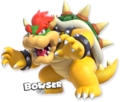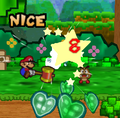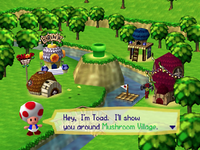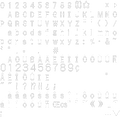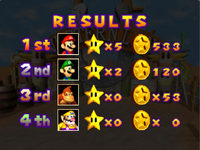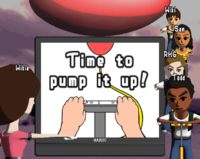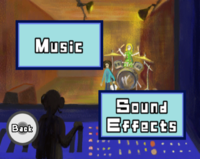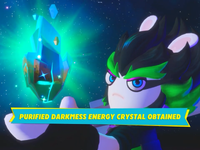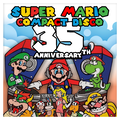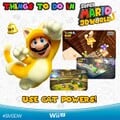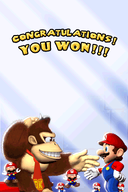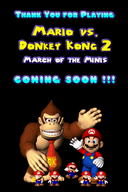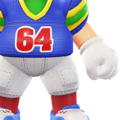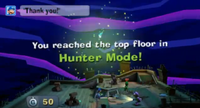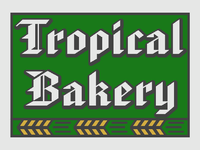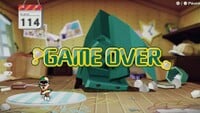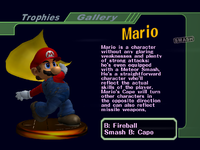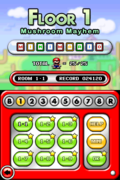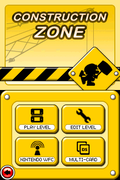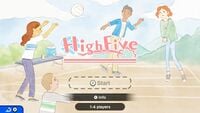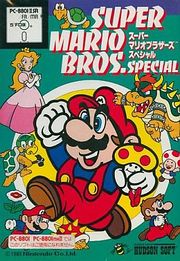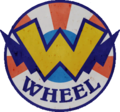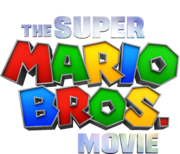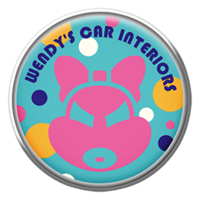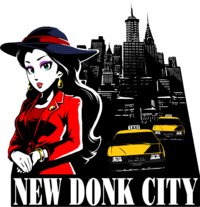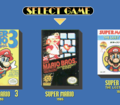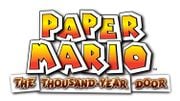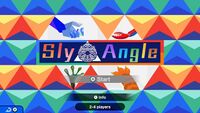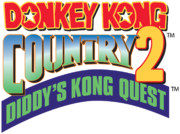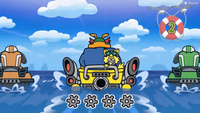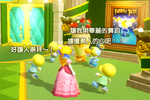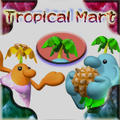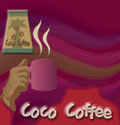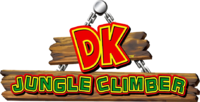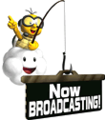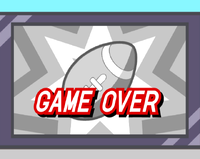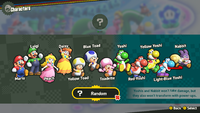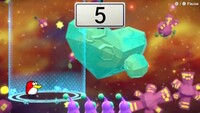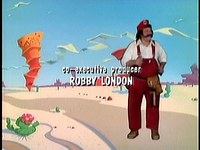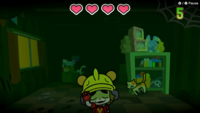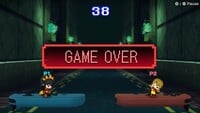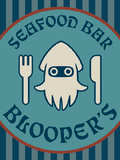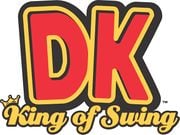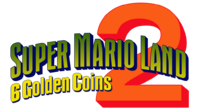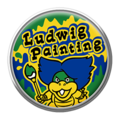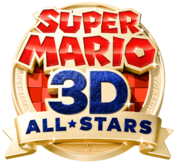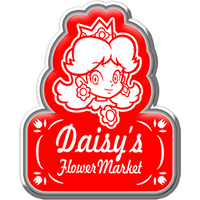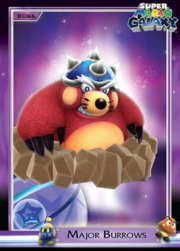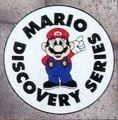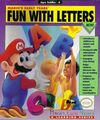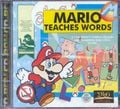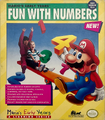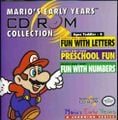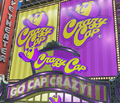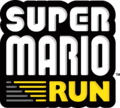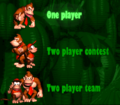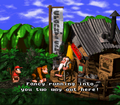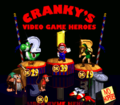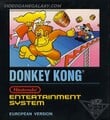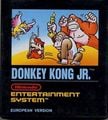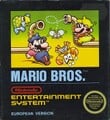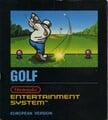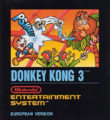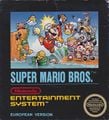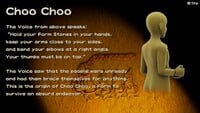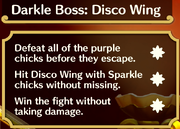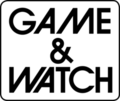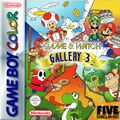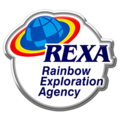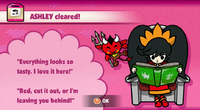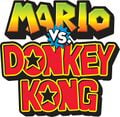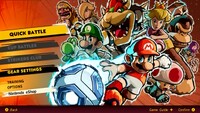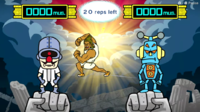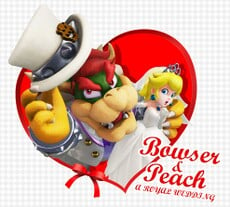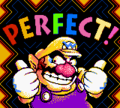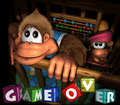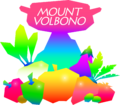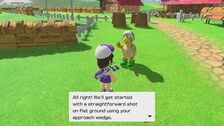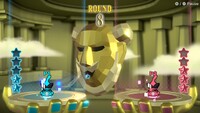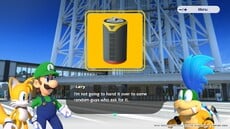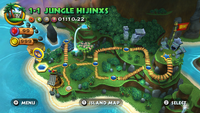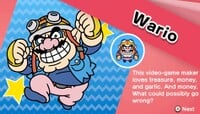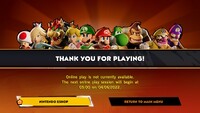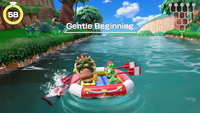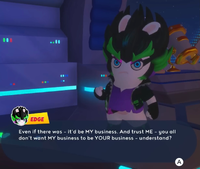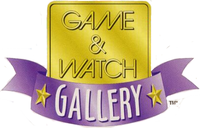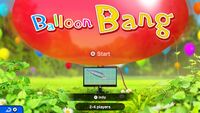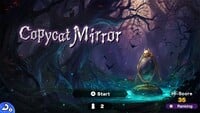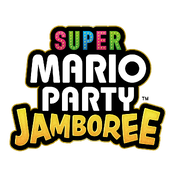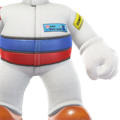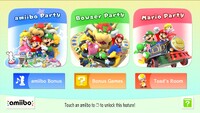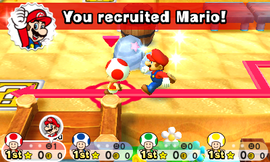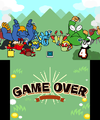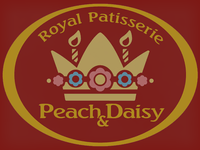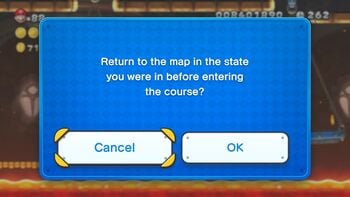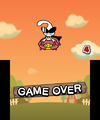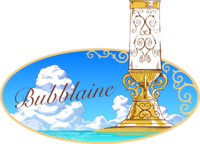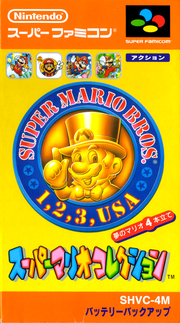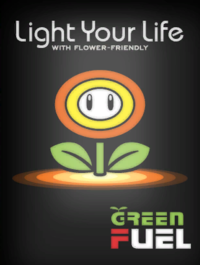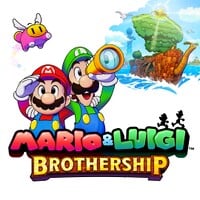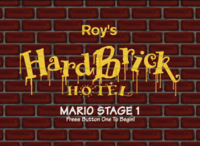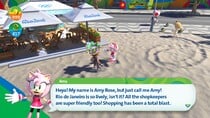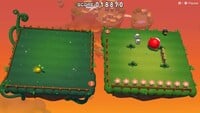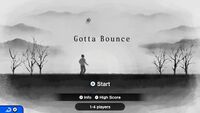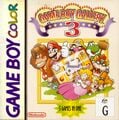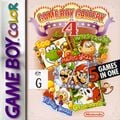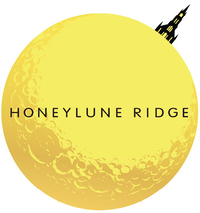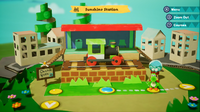List of fonts: Difference between revisions
DryKirby64 (talk | contribs) m (→Rat Fink Heavy) |
DryKirby64 (talk | contribs) m (→Comic Mystery) |
||
| Line 1,272: | Line 1,272: | ||
====Comic Mystery==== | ====Comic Mystery==== | ||
'''Comic Mystery''' (コミックミステリ ''Komikkumisuteri'')is an alternative version of Matisse released in 2008.<ref name="ComicMystery">Fontworks. コミックミステリ Std. https://lets.fontworks.co.jp/fonts/176. Retrieved July 13, 2024.</ref> It is used for text for Bowser's invitation in ''Mario Superstar Baseball'', text in [Ashley (minigame)|Ashley]] in ''Game & Wario'', text in Ashley's stage and the logo for Sneaky Gamer in ''WarioWare Gold'', and the interface of the [[Luigi's Mansion (Nintendo 3DS)|Nintendo 3DS remake of ''Luigi's Mansion'']]. | '''Comic Mystery''' (コミックミステリ ''Komikkumisuteri'')is an alternative version of Matisse released in 2008.<ref name="ComicMystery">Fontworks. コミックミステリ Std. https://lets.fontworks.co.jp/fonts/176. Retrieved July 13, 2024.</ref> It is used for text for Bowser's invitation in ''Mario Superstar Baseball'', text in [[Ashley (minigame)|Ashley]] in ''Game & Wario'', text in Ashley's stage and the logo for Sneaky Gamer in ''WarioWare Gold'', and the interface of the [[Luigi's Mansion (Nintendo 3DS)|Nintendo 3DS remake of ''Luigi's Mansion'']]. | ||
===MS Gothic=== | ===MS Gothic=== | ||
Revision as of 02:04, July 16, 2024
It has been requested that more images be uploaded for this article. Remove this notice only after the additional images have been added. Specific(s): Illustrate all fonts listed
This is a list of typefaces and fonts used in games and related media within the Super Mario franchise.
Classic Super Mario font
The first Super Mario font is an uneven sans-serif typeface designed by Nintendo in 1988. It is used for the logos and, later, interfaces of Super Mario games from Super Mario Bros. 3 to Mario & Sonic at the London 2012 Olympic Games.
Though mostly the same, a second version of the font was designed following the release of Super Mario 64, which would take over as the primary version from then on. It lacked a fully defined character set, which led to many different interpretations. In particular, the font does not have a consistent design for Japanese hiragana, katakana, or kanji. This remained the case for the font even after the overhaul, likely inciting the shift over to the modern Super Mario font.
Used in tandem with other fonts throughout the 2000's, it was fully replaced with the modern font with the release of Super Mario 3D Land, being last seen on the logo for Mario & Sonic at the London 2012 Olympic Games, albeit an early logo for Paper Mario: Sticker Star used a design partially based on this typeface before being changed to the modern Super Mario typeface for the final release.
Modern Super Mario font
The modern Super Mario typeface is an uneven sans-serif typeface designed by Nintendo in the early 2010s. It was experimented with by Nintendo in the lead up to the release of the Nintendo 3DS and Wii U, with the first use of the modern font appearing in the spine art of Super Mario Galaxy 2. Early versions appeared in games such as Mario Sports Mix, featuring a character set closer to the classic font. The font in its current form was officially introduced with the release of Super Mario 3D Land in 2011 and has since become the singular Super Mario typeface, used for logos, menus, HUDs, and other text across the Super Mario franchise.
The font is officially called "MARIO Font" and was created in collaboration with Fontworks, a foundry whose fonts are often used in Nintendo games. Unlike the previous font, this font has full character sets for hiragana and katakana, as well as some kanji and Cyrillic characters. The font has been revised at least three times; the latest revision of the font is version 3.203, revised on August 20, 2019.[1]
Logo for Super Nintendo World
English/international logo for The Super Mario Bros. Movie
Lettering seen in the May 2023 game update trailer for the Game Boy Advance - Nintendo Switch Online application[2]
Picture of Mario in which his name, using this typeface, is also shown
Donkey Kong's name
Luigi's name
Cat Mario's name
Toad's name
Picture of Bowser in which his name, using this typeface, is also shown
Peach's name
Modern Super Mario Bros. typeface
The modern Super Mario Bros. typeface is first seen in New Super Mario Bros.. This is based on the in-game logo for Super Mario Bros., which was in turn used as the logotype for the Super Mario All-Stars version of Super Mario Bros., as well as Super Mario Bros. Deluxe.
It is geometrical with vertical stems with circular joints for shapes such as "A" and "M" and horizontal strokes that end before meeting left-hand vertical stems. A small version of its glyphs is used for the "SUPER" text in games using the Super Mario Bros. name, and Super Mario Bros. Wonder introduces a lowercase set of characters for the font, which is based on Sunblock Pro.
Other than every New Super Mario Bros. game logo as well as Puzzle & Dragons: Super Mario Bros. Edition and Super Mario Run, it is also seen in Mario Super Sluggers and Super Mario Bros. Wonder for display text, as well as in The Super Mario Bros. Movie for the Super Mario Bros. Plumbing logo.
The preliminary logo for New Super Mario Bros. used a design drawn from Super Mario Bros. Deluxe
Classic HUD font
This design was used from Super Mario 64 until Mario and Sonic at the London 2012 Olympic Games for the Nintendo 3DS, appearing throughout games on the Nintendo 64, GameCube, and Wii. Some of its distinct features are the pointed, obelisk-shaped "A", the flat, wide "E", and the overall stocky, top-larger-than-bottom measures, giving it a more whimsical appearance if compared to earlier Super Mario typefaces, which were designed in the opposite way.
This typeface was primarily used for in-game text outside of dialogue (i.e HUDs and menus). Given the lack of standardization on the first Super Mario typeface, this one was also often used for placeholder logos, at times when new characters for the first font could not be drawn. It was also used for the logo of Super Mario Sunshine, Super Princess Peach and Dance Dance Revolution: Mario Mix.
Yoshi Topsy-Turvy Japanese logo
Preliminary logo for Super Mario Galaxy
Paper Mario font
A design similar to the classic HUD design above, used for in-game display text in Paper Mario games up to Paper Mario: Sticker Star.
The Letter "p", an item in Paper Mario: The Thousand-Year Door
Super Mario Maker typeface
The Super Mario Maker font is a geometric sans-serif typeface first designed by Nintendo in 2015. It is used for the interface in Super Mario Maker, Super Mario Maker for Nintendo 3DS, and Super Mario Maker 2. The initial variant of the font was titled "MARIO30th" and lacked lowercase characters. It was revised in 2018 to include lowercase letters; this new version is named "MARIOMAKER". The latest revision of the font is version 1.3, revised on November 28, 2018.[1]
Mario Party Textbox
Mario Party Textbox is used for the interface in the English version of Mario Party.
Mario Party Textbox FR/DE
Mario Party Textbox FR/DE is used for the interface in the French and German versions of Mario Party.
Mario Party 2/3 Textbox
Mario Party 2/3 Textbox is, as the name implies, used for the interface in Western versions of Mario Party 2 and 3.
Mario Party 4-7 Textbox
Mario Party 4-7 Textbox is, as the name implies, used for the interface in Western versions of Mario Party 4, 5, 6, and 7, as well as Dance Dance Revolution: Mario Mix and the European version of Mario Party 8.
Mario Party 8 Textbox
Mario Party Textbox is, as the name implies, used for the interface in the English version of Mario Party 8.
Mario Party Hudson
Mario Party Hudson is used for large text in all Hudson Soft-developed Mario Party installments, as well as Dance Dance Revolution: Mario Mix.
WarioWare typeface
A rounded typeface was used in the WarioWare series from WarioWare, Inc.: Mega Microgame$! to WarioWare: D.I.Y. Showcase. Despite no longer being used as the interface font by then, it was still used for the countdown of the Bomb until WarioWare Gold.
Geometrical WarioWare typeface
A geometrical typeface was used in WarioWare, Inc.: Mega Party Game$! and WarioWare: Smooth Moves.
Rabbids typeface
A typeface used for the Rabbids series, officially named "Rabbids" and designed by OMSE Type, is used for the interface in Mario + Rabbids Sparks of Hope for display text.
Super Mario 256
Super Mario 256 is a fanmade font designed to replicate the modern Super Mario typeface, and was created by DaFont user fsuarez913.[3] The typeface was first published online in 2012, and quickly became widespread.[4] Compared to the font it imitates, Super Mario 256 is slightly bolder and wider, and several characters are drawn at different angles.
Despite its nature as an unofficial fan project, Super Mario 256 has made its way into official media on multiple occasions. In particular, the covers for Super Mario Manga Mania and Super Mario Compact Disco – 35th Anniversary Edition, the LEGO Super Mario set "Nabbit at Toad's Shop", the logo for LEGO Super Mario Goal and the in-game score, a few social media advertisements for Super Mario 3D World and the Nintendo Switch remake of Super Mario RPG, and the Japanese Square Enix strategy guide for Super Mario RPG on Nintendo Switch feature the typeface.[5]
Chlorinap
Chlorinap is an unofficial font made to replicate the look of the classic Super Mario font, first published as early as 2005.[6] While the available font is outlined, a solid version of it is used in Mario vs. Donkey Kong 2: March of the Minis for the victory screen, and also in the end screen of the game's demo version.
Licensed and other external designs
Aachen

Aachen is a slab-serif typeface designed by Colin Brignall for Letraset, first released in 1969.[7]
Aachen Bold is used for the logo of the European-exclusive Nintendo Classics re-release of Mario Bros., in the Japanese logo for Virtual Boy Wario Land, in Super Mario Odyssey in the Football Uniform, and also in Mario Kart 8, Mario Kart Tour and Mario Kart 8 Deluxe on the logo of the 1-Up Fuel and Mario Super Motor Team businesses.
Ad Lib
Ad Lib is an uneven sans-serif typeface designed by Freeman Craw for the American Type Founders, first released in 1961.[8] It is used for the interface in the following games:
It is also used in the logo for WarioWare, Inc.: Mega Party Game$! as well as in the western instruction booklets for Mario Party 4 and 5.
Allegro
Allegro is a serif typeface designed by Hans Bohn for Ludwig & Meyer, first released in 1936. It is used in Mario Kart 8, Mario Kart Tour and Mario Kart 8 Deluxe on the logo for Fuzzy Battery.
American Text
American Text is a blackletter typeface designed by Morris Fuller Benton for the American Type Founders, first released in 1932.[9] It is seen in Mario Kart 8, Mario Kart 8 Deluxe] and Mario Kart Tour, where it is featured on the logotype for Tropical Bakery.
American Typewriter
American Typewriter is a slab-serif typeface designed by Joel Kaden and Tony Stan for ITC, first released in 1974.[10] It is used for the logos for the following games:
- Mario's Picross
- Dr. Mario: Miracle Cure (ITC American Typewriter Pro Bold)
Anito
Anito (アニト Anito) is a rounded sans-serif typeface designed by Yutaka Satō[11] for Type Labo, first released in 2001.[12] It is used for the interface in Super Mario Maker. The typeface was also used in the tentative logo for that game during E3 2014, then named Mario Maker.
Antique Olive
Antique Olive is a humanist sans-serif typeface designed by Roger Excoffon for the Fonderie Olive, first released between 1962 and 1966.[13] It is used in the logo for Mario Tennis: Ultra Smash. A modified variant is also used for the logo of Yoshi Touch & Go.
Aokane
Aokane (あおかね Aokane) is a rounded sans-serif typeface designed by Yoshiharu Ōsaki for Fontworks, first released in 2015.[14] It is used for the interface in Tetris 99, text in WarioWatch in WarioWare Gold, text in Mona and Penny's stages in WarioWare: Get It Together!, and text in the Pool-Party Panic stage in WarioWare: Move It!.
A-OTF Folk Pro
A-OTF Folk Pro is a sans-serif typeface from Morisawa. It is used for the interface in Super Smash Bros. Melee, Super Smash Bros. Brawl, and Super Smash Bros. for Nintendo 3DS/Wii U.
A-OTF Shin Go
A-OTF Shin Go is a geometric sans-serif typeface from Morisawa. It is used for the interface in Super Smash Bros. Brawl.
Arial
Arial is a sans-serif typeface designed by Patricia Saunders and Robin Nicholas for Monotype, first released in 1981.[15] It was used for the HUD of the E3 preview of New Super Mario Bros. Wii.
Arial Black is used in Super Smash Bros. Melee for display text. It is also used in the logo of Super Mario 64 DS, text in Mario's Puzzle Party in Mario Party 3, text in the puzzle game in Mario & Luigi: Bowser's Inside Story, and in signage in The Super Mario Bros. Movie.
In Mario Kart DS and Mario Kart Wii, Arial Black is also used for the Dangerous!!! service logo. In Mario Kart Arcade GP, it was used for the Mario Motors advertisements. In Mario Kart Arcade GP 2, it is used on the logos for the following businesses:
- Diamond City (Arial and Arial Black)
- King Castle (Arial Black)
- Mario World (Arial Black)
- Yoshi Company (Arial Black)
Arial Rounded
Arial Rounded is a sans-serif typeface derived from Arial. It is used for interface text in Mario vs. Donkey Kong 2: March of the Minis. It is also used for the logo of Dr. Mario Online Rx
Arnold Böcklin
Arnold Böcklin is a serif typeface released in 1904 by the Otto Weisert foundry.[16] It is seen in Mario Kart 8, Mario Kart Tour and Mario Kart 8 Deluxe on the logo for Undead Motors.
Baby Pop
Baby Pop (ベビポップ Bebi Poppu) is a Point of Purchase typeface from Fontworks, first released in 2015.[17] It is used for text in Ashley's stage in WarioWare Gold, text in the Variety Towers and the logo for High Five in WarioWare: Get It Together!.
Banco
Banco is a sans-serif display typeface designed by Roger Excoffon for the Founderie Olive, first released in 1951.[18] It is used for the Super Mario Bros. Special logo on the boxart for the game.
Bauhaus
Bauhaus is a sans-serif typeface designed by Joe Taylor for FotoStar, first released in 1969.[19] It is used in the logo for amiibo, as well as in the logos for the following games:
- Yoshi's Island: Super Mario Advance 3
- Super Mario Advance 4: Super Mario Bros. 3 (modified)
- Nintendo Land
- Mini Mario & Friends: amiibo Challenge
it is also seen in Mario Kart Tour and Mario Kart 8 Deluxe on the Green Fuel advertisement posters.
Belwe Roman
Belwe Roman is a serif display typeface designed by Georg Belwe for the Schelter & Giesecke Type Foundry, first released in 1907.[20] It is seen in Mario Kart 8 and Mario Kart 8 Deluxe in the logos for the following businesses:
Berlin Sans
Berlin Sans is a sans serif typeface designed by David Berlow, Lucian Bernhard and Matthew Butterick for the Font Bureau and FontFont, first released in 1992.[21][22] It is used in its heavier variants for the KONG Letters, including DK's Tree House's KONG sign in Donkey Kong Country games starting with Donkey Kong Country Returns.
Blackplotan
Blackplotan is a sans-serif typeface designed by Situjuh Nazara for 7NTypes, first released in 2014.[23] It is used in the logo for The Super Mario Bros. Movie.
Blippo
- Possible alternatives include: Bauhaus 93.
Blippo is a sans-serif typeface designed by Joe Taylor as a facsimile of Bauhaus and first released by Fotostar in 1969.[24] It is seen in Mario Kart Tour on the badge design for Wendy's Car Interiors.
Blue Global
Blue Global is a sans-serif typeface designed by Benoit Desprez for T-26, first released in 2002.[25] It is used for the "Snapped" text in the WarioWare: Snapped! logo.
Bodoni Poster
Bodoni Poster[26] or Poster Bodoni[27] is a serif typeface designed by Chauncey H. Griffith, released by Linotype in 1929.[27]
It is used in Super Mario Odyssey for the logo of New Donk City seen in the New Donk City Festival ad as well as its sticker. It is seen in Mario Kart Tour and Mario Kart 8 Deluxe on the poster for Chase!: Mario's Adventure.
Bookman Old Style
Bookman or Bookman Old Style is a serif typeface designed for Miller & Richard, first released in 1869.[28] It is used for the Western Land logo in Mario Party 2, and the Bookman Bold font is used for the Peach Castle sponsor in Mario Kart Arcade GP 2.
ITC Bookman
ITC Bookman is an alternative version of Bookman Old Style designed by Ed Benguiat for ITC, first released in 1975.[29] It is a variant of Bookman and is used in The Adventures of Super Mario Bros. 3 for episode title cards, in its Bold variant.
Broadway
Broadway is a sans-serif display typeface designed by Morris Fuller Benton for the American Type Founders, first released in 1928.[30] It is used for the display text of "SELECT GAME" in Super Mario All-Stars and the year headings in Super Mario 3D All-Stars on the game-selection screens. It is also used for ranked badges in Mario Kart Tour.
Brush Script
Brush Script is a casual script typeface designed by Robert E. Smith for the American Type Founders, first released in 1942.[31]
It is used in Super Mario Odyssey on the Forgotten Isle sticker. In Mario Kart 8, Mario Kart Tour and Mario Kart 8 Deluxe, it is seen in the logo for Wario Billionaires.
Cancun
Cancun is a sans-serif typeface designed by Howard A. Trafton for Corel, first released in 1992.[32] It is used in the logo for Paper Mario: The Thousand-Year Door.
Carat
Carat (カラット Karatto) is a typeface from Fontworks, first released in 2010.[33] It is used in the logo for WarioWatch and text in WarioWatch and Cruise Control in WarioWare Gold, as well as in Wario's and Dribble & Spitz's levels and in the Play-o-Pedia in WarioWare: Get It Together!, and the logo for Galactic Conquest in WarioWare: Move It!.
Century Gothic
Century Gothic is a geometric sans-serif typeface designed by Sol Hess for Monotype, first released in 1990.[34] It is used for the score text in Shy Guy Smash! in Mario vs. Donkey Kong 2: March of the Minis.
Chiaro
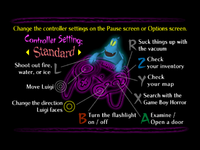
Chiaro (キアロ Kiaro) is a sans -serif typeface from Fontworks, first released in 1997.[35] It is used for controller setting texts in Luigi's Mansion and the interface of Nintendo Land.
Comet
Comet (コメット Kometto) is a geometric sans-serif typeface from Fontworks, first released in 2010.[36] It is used for the Japanese logo of Arrow in Game & Wario and the logo for Sly Angle in WarioWare: Get It Together! and the text in the Volcano Wario stage in WarioWare: Move It!.
Comic Sans
Comic Sans is an uneven sans-serif typeface designed by Vincent Connare for Microsoft, first released in 1994.[37]
In Mario Party, it is used on the logo for Bowser's Magma Mountain, and is also seen in the Mini-Game Stadium background graphic for the "START" sign; it is also used for all boards' names when viewing the post-game results. In Diddy Kong Racing DS, it is used when text is displayed above the keyboard. In Super Mario RPG for the Nintendo Switch, it is used on the "Welcome" sign in the Mushroom Castle area.[38]
Compacta
Compacta is a condensed sans-serif typeface designed by Fred Lambert for Letraset, first released in 1963.[39] It is used for interface text in Super Smash Bros. Brawl, albeit with a modified 0. It is also used for the logo for Donkey Kong Country 2: Diddy's Kong Quest.
Cooper Black
Cooper Black, released in 1922, is a serif typeface and a heavy weight derivative of Cooper, released in 1919, designed by Oswald Cooper.[40] It is used for cutscene text in Mario vs. Donkey Kong. It is also used in Mario Kart 8, Mario Kart Tour and Mario Kart 8 Deluxe on the banner ads for Wendy's Car Interiors.
Copperplate Gothic
Copperplate Gothic is a wedge serif typeface designed by Frederic W. Goudy for American Type Founders, first released in 1901.[41] It is used on the Mystery Land logo in Mario Party 2.
Cruz Swinger
Cruz Swinger or Swinger is a decorative typeface designed by Ray Cruz originally published by John N. Schaedler circa 1970.[42] It is used in WarioWare: Touched! for the illustrative title cards seen in many Souvenirs, such as Kitchen Timer, Clacker and Yo-Yo.
Cuckoo
Cuckoo (カッコウ Kakkō) is a Point of Purchase typeface designed by Tomomi Kanda for Fontworks, first released in 2021.[43] It is used for text in Dribble & Spitz's stage in WarioWare: Move It!.
DF Kyo Geki
DF Kyo Geki (DF京劇体 DF Jīngjù Tǐ) is an uneven sans-serif typeface from DynaComware. It is used for the interface in the following games:
- Mario Party 8 (American and Japanese versions)
- Luigi's Mansion: Dark Moon (Japanese, Traditional Chinese and Russian versions)
- Luigi's Mansion Arcade
DF Li Yuan
DF Li Yuan (華康儷圓 Huá kāng Lì Yuán) or DF PT R9 is a typeface for Traditional Chinese released by DynaComware.[44] It is used for the interface in the following games: Paper Mario: The Origami King (Traditional Chinese language) Princess Peach: Showtime! (Traditional Chinese language)
DF Pop Mix
DF Pop Mix (DF POPミックス DF Poppu Mikkusu) is a Point of Purchase typeface from DynaComware. It is used for the interface in the following games:
- Mario Party 8 (Japanese language)
- Mario Party DS
- Luigi's Mansion 3 (Japanese language)
DF Taru Gothic
DF Taru Gothic (DF樽ゴシック体 DF Taru Goshikkukarada) is a display from DynaComware. It is used for the logo of Bowling in Game & Wario.
DF UD Gothic
DF UD Gothic (華康UD黑 Huá kāng UD Hēi) is a Universal Design sans-serif typeface from DynaComware. It is used for the interface in Super Mario Maker 2 for the Japanese language.
DF Xing Kai
DF Xing Kai (華康行楷體 Huá kāngxíng Kǎitǐ) or DFP Gyō Kaisho (DFP行楷書 DFP Xíng Kǎishū) is a script typeface by DynaComware.
It is used for text from the Temple of Form in WarioWare: Smooth Moves in Japanese and languages using the Latin script. It is also used in WarioWare: D.I.Y. as one of the font styles available for use in the Super MakerMatic 21, called Calligraphy.
DFP Craft Sumi
DFP Craft Sumi (DFPクラフト墨 DFP Kurafuto Sumi) is a typeface from DynaComware. It is used for several business graphics in Mario Kart Wii:
- Fun Flower (returns in Mario Kart 7)
- The Mushroom Moon
- Nintendo Moo Moo Farm
- Tropical Mart
Being also used for interface text in Pikmin games, it is present in WarioWare: Smooth Moves and WarioWare Gold in the microgame Pikmin 2.
DFP Fang Yuan
DFP Fang Yuan (华康方圆体 Huá kāng Fāngyuán Tǐ) is a Point of Purchase typeface from DynaComware. It is used for the interface in the Simplified and Traditional Chinese versions of Mario Tennis Open.
DFP Fūun
DFP Fūun (DFP風雲体 DFP Fēngyún Tǐ) is a typeface from DynaComware. It is seen in Mario Kart Wii in the poster ads for Coco Coffee and Green Fuel for the "with flower-friendly" portion.
DFP HS Gothic
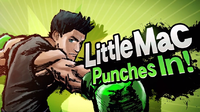
DFP HS Gothic (DFP平成ゴシック体 DFP Heisei Goshikkukarada) is a sans-serif typeface from DynaComware.[45] It is most prominently used in Super Smash Bros. games, with the exception of Ultimate. In the original Super Smash Bros., it is used for pre-match loading screens in the 1P Game, as well as unlock messages; in Melee and Brawl, it is used for How to Play, as well as the interface in the Japanese language for the latter.
Its large variant, DFP Gothic (DFP特太ゴシック体 DFP Tokubuto Goshikkukarada) is used in Super Smash Bros. for Nintendo 3DS/Super Smash Bros. for Wii U|Wii U as the primary large text font. It is also used for text in Jimmy T and Jimmy P.'s stages in WarioWare: Smooth Moves and text in the Simplified Chinese versions of Dr. Mario Express, Super Mario 3D Land, Mario Kart 7, New Super Mario Bros. 2, Mario Kart Tour, WarioWare: Get It Together!, and WarioWare: Move It!. It is also used in the Traditional Chinese versions of Super Mario 3D Land, Mario Kart 7, New Super Mario Bros. 2, and Mario Kart Tour.
It is also has minor usage in Mario Kart 8 and Mario Kart 8 Deluxe on the Bullet Bill Speed Trials logo, which uses its Ultra Heavy (太) font.
DFP HS Maru Gothic
DFP HS Maru Gothic (DFP平成丸ゴシック体 DFP Heisei Maru Goshikkukarada) is a rounded typeface from DynaComware. It is used for text in Kat and Ana's stage in WarioWare: D.I.Y. Showcase and the interface in the Traditional Chinese version of Mario Party 9.
DFP Kai Sho
DFP Kai Sho (DFP中太楷書体 DFP Zhōng Tài Kǎishū Tǐ) is a serif typeface from DynaComware. It is used for display text in Super Smash Bros. Melee.
DFP Kan Tei Ryu
DFP Kan Tei Ryu (DFP勘亭流 DFP Kāntíngliú) is a script typeface from DynaComware. It is used for the interface in the following games:
- Wario World
- Nintendo Land
DFP Koln
DFP Koln (DFP康印体 DFP kāng Yìn Tǐ) is a rounded typeface from DynaComware. It is used in WarioWare: D.I.Y. as one of the font styles available for use in the Super MakerMatic 21.
DFP Lei Ga So
DFP Lei Ga So (DFP麗雅宋 DFP Lì Yǎ Sòng) is a serif typeface from DynaComware. It is used for the interface in the following games:
- Dance Dance Revolution: Mario Mix (American and Japanese languages)
- Mario Party 8 (American and Japanese languages)
DFP Maru Gothic
DFP Maru Gothic (DFP中太丸ゴシック体 DFP-chū Tamaru Goshikkukarada) is a rounded typeface from DynaComware. It is used for the interface in the following games:
- Donkey Kong Country Returns 3D (Japanese language)
- Super Mario Run (Traditional Chinese language)
- Dr. Mario World (Simplified and Traditional Chinese languages)
DFP Maru Moji
DFP Maru Moji (DFPまるもじ体 DFP Marumojitai) is a Point of Purchase typeface from DynaComware. It is used for the interface in the Japanese versions of Yoshi's New Island.
DFP Mincho
DFP Mincho (DFP華康明朝体 DFP Huá kāngmíng Cháo Tǐ) is a serif typeface from DynaComware. It is used for the interface in the following games:
- WarioWare: D.I.Y.
- Super Smash Bros. Brawl.
- Super Smash Bros. for Wii U
DFP Pop
DFP Pop (DFP POP体 DFP Poppu-tai) is a Point of Purchase typeface from DynaComware. It is used for the interface in the following games:
- Dance Dance Revolution: Mario Mix (English and Japanese language)
- Mario Kart Arcade GP
- Mario Kart Arcade GP 2
- Luigi's Mansion: Dark Moon (Simplified Chinese language)
It is also used for text in Wario-Man, Dribble and Spitz, and Kat and Ana's stages in WarioWare: D.I.Y. Showcase.
Its Traditional Chinese variant, DF POP (華康POP體 Huá kāng POP Tǐ) is used for the interface in Super Mario Galaxy 2 for the Traditional Chinese language.
DFP Ru Lei
DFP Ru Lei (DFP流隷体 DFP Liú Lìtǐ) is a script typeface from DynaComware. It is used for the interface of Wario World.
DFP Sō Gei
DFP Sō Gei (DFP綜藝体 DFP Zōngyì Tǐ) is a geometric sans-serif typeface from DynaComware. It is used for the interface in the following games:
- Super Smash Bros. Melee
- Mario Superstar Baseball
- Mario Party 8
- Mario Super Sluggers
- Super Mario Maker (Japanese language)
- Super Mario Maker 2 (Japanese language)
- Luigi's Mansion 3 (Japanese language)
It is used on the logo for DK: Jungle Climber. In Mario Superstar Baseball, it is also used for the special move logos.
It is also minorly seen in Mario Kart Arcade GP 2, where it is seen on Lakitu's sign, WarioWare: Smooth Mooves, for text in Darts, and WarioWare: D.I.Y. Showcase, for Wario-Man's level title screen, text in Dribble & Spitz's stage, as well as the Diamond Taxi ad screen.
Its Simplified Chinese variant, DFP Zong Yi (华康新综艺 Huá kāng Xīn Zōngyì) is used for the copyright text in the Simplified Chinese version of Super Mario Galaxy.
DFP Yuan
DFP Yuan (华康圆体 Huá kāng Yuán Tǐ) is a rounded sans-serif typeface for Simplified Chinese released by DynaComware. It is used for the interface in the following games:
- Paper Mario: Sticker Star (Simplified and Traditional Chinese versions)
- Paper Mario: The Origami King (Simplified Chinese versions)
DIN 1451
DIN 1451 is a sans-serif typeface from DIN, first released in 1931.[46] It is used for text in Mona's stage in WarioWare: Smooth Moves.
DIN 2014
DIN 2014 is an alternative version of DIN 1451 designed by Vasily Biryukov for ParaType, first released in 2014.[47] It is used for the interface in Super Mario Bros. Wonder and Nintendo World Championships: NES Edition.
DNP Shuei Antique
DNP Shuei Antique (DNP 秀英アンチック DNP Shūei Anchikku) is a sans-serif typeface designed by Dai Nippon Printing for Fontworks, first released in 2017.[48] It is used for text in Dribble & Spitz's stage in WarioWare: Get It Together!.
Dom Casual
Dom Casual is a casual script typeface designed by Peter Dom for American Type Founders, first released in 1963.[49] It is used both in The Super Mario Bros. Super Show! and the Donkey Kong Country television series (in its bold variant) for general text, including title cards and credits information. It is also used in the Super Mario World television series for credits only.
Dot Gothic12
Dot Gothic12 (ドットゴシック 12 Dotto Goshikku 12) is a pixelated sans-serif typeface from Fontworks, first released in 2006.[50] it is used in the logo for Sneaky Gamer in WarioWare Gold, text in 9-Volt's stage in WarioWare: Move It! and Patissiere Peach's stage in Princess Peach: Showtime!.
Dot Gothic16
Dot Gothic16 (ドットゴシック 16 Dotto Goshikku 16) is a pixelated sans-serif typeface from Fontworks, first released in 2006.[51] It is used for text in 9-Volt's stages in WarioWare Gold and WarioWare: Get It Together!.
Eckmann
Eckmann, Eckmann-Type or Eckmann-Schrift is a typeface designed by Otto Eckmann and first released by Klingspor Type Foundry in 1900.[52] In Mario Kart Tour and Mario Kart 8, it is used in the logo for Blooper's Seafood Bar.
Eclat
Eclat is a script typeface designed by Doyald Young for Letraset, first released in 1986.[53] It is used for the European/Australasian logo for DK: King of Swing.
El Grande
El Grande is a sans-serif typeface designed by Jim Parkinson for The Font Bureau, first released in 1993.[54] It is used for the North American logo for Mario & Luigi: Dream Team.
Enge Wotan-Grotesk
Enge Wotan-Grotesk is a sans-serif typeface developed by German company Wagner & Schmidt circa 1914.[55] It serves as the basis for the logo of Super Mario Land 2: 6 Golden Coins, with alterations to the bars of the A and the E, and the bowl of the P, which are angled upward.
Eras
Eras is a humanist sans-serif typeface designed by Albert Boton and Albert Hollenstein for ITC, first released in 1976.[56] Eras Bold is used in Super Smash Bros. Melee for the ordinal number suffixes on the winner screen.
Eras Bold is also seen for the number "2" in the end screen of the demo version of Mario vs. Donkey Kong 2: March of the Minis. It is also used for the "Arcade GP" text in the Mario Kart Arcade GP series logo.
Estro
Estro is a serif typeface designed by Aldo Novarese for Nebiolo, first released in 1961.[57] It is seen in Mario Kart 8, Mario Kart Tour, Mario Kart 8 Deluxe and Yoshi's Crafted World for the logo for Princess Orange, and in Tour for the Ludwig Painting logo.
FF CrashBangWallop
FF CrashBangWallop is a sans-serif typeface designed by Rian Hughes for FontFont, first released in 1970.[58] It is used for the North American logo for Mario Hoops 3-on-3.
FF Mark
FF Mark is a geometric sans-serif typeface designed by Hannes von Döhren and Christoph Koeberlin for FontFont, first released in 2013.[59] It is used for the logo for Super Mario 3D All-Stars. It has also been largely used as the main typeface for Nintendo's branding since the release of the Nintendo Switch, such as the logo for Nintendo Switch Online. It is also used for the interface in Nintendo World Championships: NES Edition.
Frankfurter
Frankfurter is a rounded sans-serif typeface designed by Bob Newman for Letraset, first released in 1970.[60] It is used for the Greenhouse game in Game & Watch Collection.
Frankfurter Highlight
Frankfurter Highlight is a rounded sans-serif typeface and an extension to Frankfurter designed by Nick Belshaw for Letraset, first released in 1978.[61] It is used in Mario Kart 8 and Mario Kart 8 Deluxe on the logo for Green Service.
Franklin Gothic
Franklin Gothic is a sans-serif typeface designed by Morris Fuller Benton for the American Type Founders, first released between 1902 and 1967.[62] It is used for the Donkey Kong and Oil Panic games in Game & Watch Collection.
Freehand 521
Freehand 521 is a script typeface from Bitstream and a digital version of 1934's Mandate, which was designed by Robert Hunter Middleton.[63] It is used in Mario Kart Tour and Mario Kart 8 Deluxe for the logo for Daisy's Flower Market.
Friz Quadrata
Friz Quadrata is a serif typeface designed by Ernst Friz and Victor Caruso for Visual Graphics Corporation, first released in 1965.[64] It is used on the character name text on Super Mario Galaxy trading cards.
Frutiger
Frutiger is a humanist sans-serif typeface designed by Adrian Frutiger, first released in 1976.[65] It is used for text in Mario's Puzzle Party in Mario Party 3, text for the Hole-In-One Contest in the English version of Mario Golf: Toadstool Tour, and the logo for Donkey Kong Country Returns 3D.
Futura
Futura is a geometric sans-serif typeface designed by Paul Renner for the Bauer Type Foundry, first released in 1927.[66]
It is used for display interface text in Mario vs. Donkey Kong 2: March of the Minis, general interface text in Mario + Rabbids Kingdom Battle. In Mario Tennis Aces it is used for some interface text (such as HUD numbers), for the "Mario Tennis" logo on the menu background texture, and for character names on light displays on stadium courts. In Mario vs. Donkey Kong, it is used for text in the custscenes. In Super Mario Odyssey, it is used for the "GO CAP CRAZY!" text on the scrolling light up sign on the Crazy Cap building in New Donk City.
It is used in Mario Kart 8, Mario Kart Tour and Mario Kart 8 Deluxe for the ads for:
- Mario Motors
- Boomerang Bros. International Airlines
- Dino Dino Outdoor & Camping Goods
- Morton Construction
- Women of Racing Organization
In Tour, it is also used for the B-Dash ad.
It is the primary font in the western instruction booklets for Super Mario 64, Super Mario Sunshine, Mario Golf: Toadstool Tour, Mario Kart DS, and the Wii version of Mario and Sonic at the London 2012 Olympic Games.
Futura fonts are present on the logos for Mario Discovery and the boxart logos and text of all its games, as well as the European logo of Mario Hoops 3-on-3 and the Classic NES Series titles.
Futura Black
Futura Black is an alternative version of Futura released in 1929.[66] It is used in the localized versions of Mario Kart 64 for the Luigi's logo.
Futura Condensed
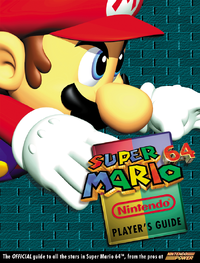
Futura Condensed is an alternative version of Futura. It is the primary font in most western instruction booklets for Nintendo 64-, Game Boy Color-, and Game Boy Advance-era games, as well as the western instruction booklets for Mario Party 4, Mario Kart: Double Dash!!, and Mario Party 5; the European instruction booklet for Mario Party 6; and the European and Australian instruction booklets for Mario Party 7.
GigaG
GigaG (ギガG GigaG) is a geometric sans-serif typeface designed by Kyoko Katsumoto and Shigeru Katsumoto for Visual Design Laboratory (視覚デザイン研究所 Shikaku Dezain Kenkyūjo), first released in 2000.[67] It is used for the interface in Mario Golf: Super Rush for the Japanese language.
GigaJr
GigaJr (ギガJr GigaJr) is a geometric sans-serif typeface designed by Kyoko Katsumoto and Shigeru Katsumoto for Visual Design Laboratory, first released in 2000.[68] It is used for the interface in Nintendo World Championships: NES Edition for display text.
Gill Sans
Gill Sans is a humanist sans-serif typeface designed by Eric Gill for Monotype, first released in 1928.[69] It is used on the logo for the Game Boy, Gill Sans Medium Italic is used for the original logo and Gill Sans Bold Italic is used for the second logo.
It is also used for the KONG Letters in the original trilogy of Donkey Kong Country games.
The Gill Sans MT Pro Display Extra Bold font is used for the logo for Super Mario Run.
In Mario Kart 8 and Mario Kart 8 Deluxe, it is used on the logos for:
- Green Shell Taxi (also present in Super Mario Odyssey and Mario Kart Tour)
- Golden Wheel
- Mario Automobile Association
- Tropical Grocery (also present in Mario Kart Tour).
Gill Kayo
Gill Kayo is an alternative version of Gill Sans released in 1936.[70] It is used extensively in Donkey Kong Country for interface text (including the "Nintendo presents" splash screen) as well as in-universe scenery text. In Donkey Kong Country 2: Diddy's Kong Quest, it is used once again for scenery signs and also for the Cranky's Video Game Heroes screen.
Cranky's Cabin sign
Funky's Flights sign
Gospel
Gospel (ゴスペル Gosuperu) is an uneven serif typeface designed by Takayuki Kuwahara for Fontworks, first released in 2016.[71] It is used for text in Young Cricket & Master Mantis's stage in WarioWare Gold, text in the Variety Tower stages and Copycat Mirror in WarioWare: Move It!.
Gotham
Gotham is a geometric sans-serif typeface designed by Tobias Frere-Jones and Jesse Ragan for Hoefler & Frere-Jones, first released in 2000.[72] Gotham Ultra is used for the logo for Super Mario 3D All-Stars.
Greco
Greco (グレコ Gureko) is a serif typeface designed by Toshiyasu Satō for Fontworks, first released in 1994.[73] it is used as a system font on the Wii.
Griffin
Griffin is a geometric sans-serif typeface designed by Rian Hughes for Device, first released in 1997.[74] A modified version of Griffin Black is used for the logo of Wario: Master of Disguise.
Hai Bao
Hai Bao is a Point of Purchase typeface for Chinese released by DynaComware. Its Simplified Chinese variant, DFP Hai Bao (华康海报体 Huá kāng hǎibào tǐ) is used for the interface in the following games:
- Super Mario Galaxy (Simplified Chinese language)
- New Super Mario Bros. Wii (Simplified Chinese language)
- Donkey Kong Country Returns (Simplified Chinese language)
- Paper Mario: Sticker Star (Simplified Chinese language)
- Dr. Mario World (Simplified Chinese language)
Its Traditional Chinese variant, DF Hai Bao (華康海報體 Huá kāng Hǎibào Tǐ) is used for the interface in the following games:
- New Super Mario Bros. Wii (Traditional Chinese language)
- Mario Party 9 (Traditional Chinese language)
- Paper Mario: Sticker Star (Traditional Chinese language)
- Super Mario Run (Traditional Chinese language)
- Dr. Mario World (Traditional Chinese language)
- Paper Mario: The Origami King (Traditional Chinese language)
- WarioWare: Get It Together! (Traditional Chinese language)
- WarioWare: Move It! (Traditional Chinese language)
Handel Gothic
Handel Gothic is a geometric sans-serif typeface designed by Donald J. Handel and Robert Trogman for FotoStar, first released in 1965.[75] Handel Gothic with a straight leg on "R", a straight lower leg on "k", and a double-v "w", modified with a short line on the top left of the "1", is used for the interface in Luigi's Mansion 3 for Western languages.
Handel Gothic is also used in the logo for Mario Power Tennis and for the "Mario Tennis" logo displayed on courts in Mario Tennis: Ultra Smash. It is also used for the "XL" subtitle on the Nintendo DS and Nintendo 3DS lineup.
In Mario Kart Wii, it is used on the poster ad for Green Fuel with a modified "e" glyph for the "light your life" slogan and the "Green Fuel" logo. In Mario Kart 8, Mario Kart Tour, Mario Kart 8 Deluxe, Super Smash Bros. for Wii U and Super Smash Bros. Ultimate, it is used on the logo for Mushroom Piston.
Helvetica
Helvetica is a sans-serif typeface created by Max Miedinger and Eduard Hoffmann, first released in 1957.[76] It is used for the logos of following games:
- Donkey Kong (Helvetica Black Condensed)
- Donkey Kong Jr. (Helvetica Black Condensed)
- Mario Bros. (Helvetica Black Condensed)
- Donkey Kong Jr. Math (Helvetica Black Condensed)
- Pinball (Helvetica Black)
- Golf (Helvetica Black)
- Donkey Kong 3 (Helvetica Black Condensed)
- Wrecking Crew (Helvetica Black Condensed)
- Super Mario Bros. (Helvetica Black)
- Super Mario Bros. 2 (Helvetica Black Condensed)
These would be retained for the logos of their Classic NES Series releases. It is also used in the logo for Ultimate NES Remix.
Its inserat roman variant is used on the European box arts of the mentioned games above (with the exception of Super Mario Bros. 2) for the games' titles.
Helvetica is also used for the interface of Mario Kart 64, the timer and damage HUDs (the latter with a modified 1) in Super Smash Bros. Melee, in Mario Kart Tour on the logo for the Yoshi business, and in Mario Kart 8, Mario Kart Tour, Mario Kart 8 Deluxe and Super Mario Odyssey on the banner for Rainbow Exploration Agency.
Helvetica Condensed rounded is also used in the stamp card in Mario Party 3.
Helvetica Neue
Helvetica Neue is a sans-serif typeface from the Stempel Type Foundry, first released in 1983.[77] It is a variant of Helvetica and is used in The Super Mario Bros. Movie for street names in the map and the on-screen text both seen in the Super Mario Bros. Plumbing commercial.
Nimbus Sans
Nimbus Sans is a sans-serif typeface designed by URW Studio for URW++, first released in 1999.[78] It is based on Helvetica. It is used for the interface in Mario Strikers Charged for western languages.
Highway Gothic
Highway Gothic is a sans-serif typeface designed by Theodore W. Forbes for the United States Federal Highway Administration (FHWA), first released in 1948.[79] It is used for text in The Super Mario Bros. Movie.
Hobo
Hobo is a sans-serif display typeface designed by Morris Fuller Benton for American Type Founders, first released in 1910.[80] It is used in Mario Kart 8, Mario Kart Tour and Mario Kart 8 Deluxe on the logos for Dream Gliders and Red Shell Strike Equipment, this last one being also seen in Super Mario Odyssey.
Hourei
Hourei (豊隷 Toyore) is a script typeface designed by Kazutoshi Fukuda for Fontworks, first released in 2002.[81] It is used in WarioWare: Move It! for the text for the Forms.
House-a-rama Kingpin
House-a-rama Kingpin, or simply Kingpin is a sans-serif typeface from House Industries, first released in 1999.[82] It is used for the "Topsy-Turvy" text in the English Yoshi Topsy-Turvy logo.
Humming
Humming (ハミング Hamingu) is a rounded sans-serif typeface designed by Shigenobu Fujita for Fontworks, first released in 2004.[83] It is used for most of the text in the following games:
- Wario Land: Shake It!
- Mario & Luigi: Dream Team
- Mario Golf: World Tour
- WarioWare Gold
- Princess Peach: Showtime! (Western, Japanese and Russian versions)
In Super Mario Sunshine, Humming is used for text in the Isle Defino map.
The font natively supports the Dutch ij digraph, to the convenience of the Dutch version of Princess Peach: Showtime!
Impact
Impact is a sans-serif typeface designed by Geoffrey Lee for Stephenson Blake, first released in 1965.[84] It is used for the logos for Super Smash Bros. Melee, Mario Tennis: Power Tour, Itadaki Street DS, Dr. Mario Express, and Mario vs. Donkey Kong: Mini-Land Mayhem!. It is also used for the "AT THE" in the Mario & Sonic series.
It is also minorly used in Mario Party 4 for the Bowser Game text, Game & Watch Gallery 4 in the modern version of the Boxing game, Mario Power Tennis for the Versus text,Donkey Kong Country 2 for the Game Boy Advance for the Cranky's Video Game Heroes banner text, Mario & Luigi: Partners in Time for the level up text, and Mario Party: Island Tour for ranking and spaces text.
ITC Avant Garde
ITC Avant Garde, ITC Avant Garde Gothic or simply Avant Garde is a geometric sans-serif typeface designed by Herb Lubalin and Tom Carnas for ITC, first released between 1970 and 1977.[85] As it is used on the logo for the Family Computer and the Game & Watch series, it is also present in the logos of certain of games that reference them:
- Golf: Japan Course
- Famicom Grand Prix: F1 Race
- Famicom Grand Prix II: 3D Hot Rally
- Game & Watch Gallery
- Game & Watch Gallery 2
- Game & Watch Gallery 3
- Game & Watch Gallery 4 (Game & Watch Gallery Advance)
- Game & Watch Collection
- Game & Wario
The Game & Watch logo uses the font's right-leaning variants of "A", "M", and "W"; the Family Computer logo uses the right-leaning variant of "A", but not "M". This is reflected in the logos that reference them. The Game & Watch Gallery Advance logo also uses the right-leaning variant of "V".
It is also used for text on the boxart of Game & Watch: Super Mario Bros. In Mario Kart 8, Mario Kart Tour and Mario Kart 8 Deluxe, it is used on the logo for Galaxy Air, which is also seen in Super Mario Odyssey. Additionally, it is used for the interface in Art Style: PiCTOBiTS, with the right-leaning variant of "A", as in the Family Computer logo.
ITC Benguiat
ITC Benguiat is a decorative serif typeface designed by Ed Benguiat for ITC, first released in 1977.[86] It is used in Mario Kart 8, Mario Kart Tour and Mario Kart 8 Deluxe on the logos for Rainbow Exploration Agency and Roy Smooth Sounds.
ITC Galliard
ITC Galliard is a serif typeface designed by Robert Granjon and Matthew Carter for Linotype, first released in 1978.[87] ITC Galliard Std Ultra is used for the logo for Super Smash Bros. Melee.
ITC Kabel
ITC Kabel is a geometric sans-serif typeface designed by Victor Caruso for ITC, first released in 1975.[88] It is a variant of Kabel and is used in Game & Wario in its Ultra variant for display as well as body text. In WarioWare Gold, it is used once again for microgame commands, like in Game & Wario's Gamer. It is also used for the HUD in Donkey Kong Country: Tropical Freeze.
ITC Kabel is also used prominently in Super Smash Bros., being present also on the game's logo. It is also present on the logos for Mario Kart 64 (Medium), Mario vs. Donkey Kong games (Bold), Mario Golf: Toadstool Tour (Ultra) and Mario & Sonic at the Rio 2016 Olympic Games Arcade Edition (Bold). Additionally, it is used in the western instruction booklets for Super Mario 64 and Mario Party.
The Japanese logos for the Game & Watch Gallery games uses the font (Bold) for the English subtitle.
In Mario Kart 8 and Mario Kart 8 Deluxe, it is seen in the logo for Waluigi Sea Bed.
ITC Kabel Bold was used for an earlier version of the logo for Super Mario World 2: Yoshi's Island and ITC Kabel Ultra was used for the logo for the unreleased English version of Nintendo Puzzle Collection.
ITC Grizzly
ITC Grizzly is an alternative version of ITC Kabel.[89] It is used in Mario Strikers: Battle League for display text.
ITC Machine
ITC Machine is a sans-serif typeface designed by Ronné Bonder and Tom Carnasse for ITC, first released in 1970.[90] It is used in the localized versions of Mario Kart 64 for interface text, as well as the Mario Star business logo.
ITC Machine is also used on the logo for the Super Mario Bros. film and much of the material related to it. A modified version is also used for the European logo of Mario Hoops 3-on-3.
Juniper
Juniper is a serif typeface designed by Joy Redick for Adobe, first released in 1990 as a digital version of the woodtype Painters Roman by Nick Curtis, released by William H. Page & Company and Vanderburgh Wells & Company in 1878.[91] It is used in Mario Kart 64 for the Yoshi business sponsor and the "BOING!" onomatopoeia generated when a kart hops.
Kafu Techno
Kafu Techno (花風テクノ Hanafū Tekuno) is a geometric sans-serif typeface designed by Arphic for Fontworks, first released in 2012.[92] It is used in the interface in Puzzle & Dragons: Super Mario Bros. Edition, WarioWare Gold in Dribble & Spitz and 18-Volt's stages, the HUD in the Nintendo 3DS remake of Luigi's Mansion, WarioWare: Get It Together! for Dr. Crygor's stage, and WarioWare: Move It! for text in the Volcano Wario stage, Megagame Muscles, and the logo for Dirty Job.
Khamden Script
Khamden Script is a script typeface designed by Riski Firmana for Solidtype, first released in 2020.[93] A modified version is used for Bowser and Princess Peach's wedding posters seen in Super Mario Odyssey.[citation needed]
Kokin Hige
Kokin Hige (古今髭 Kokon Hige) is a script typeface designed by KOKIN (Tetsushi Kogane) for Fontworks, first released in 1997.[94] It is used for text in Kat & Ana's stage in WarioWare Gold.
KoreanAGD
KoreanAGD (sometimes referred to as "아시아고딕 4종", Asian Gothic) is a gothic typeface released by Asiafont in 1999.[95] It is used for the interface in the Korean version of Super Smash Bros. Brawl.
KoreanAISK
KoreanAISK (sometimes referred to as "아이스께끼 1종", Ice Cream) is an uneven typeface released by Asiafont in 2010.[96] It is used for the interface in the Korean version of Paper Mario: Sticker Star.
KoreanAMERI
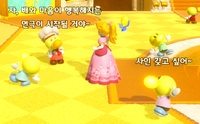
KoreanAMERI (sometimes referred to as "아메리카노 3종", Americano) is a gothic typeface released by Asiafont in 2013.[97] Its "B" variant is used for almost all text in the Korean version of Princess Peach: Showtime!.
KoreanBB
KoreanBB (sometimes referred to as "별빛 3종", Starlight) is an uneven typeface released by Asiafont in 1996.[98] It is used for the interface in the Korean version of Luigi's Mansion: Dark Moon.
KoreanBIG
KoreanBIG (sometimes referred to as "빅체 2종", Big Sieves) is a gothic typeface released by Asiafont in 1996.[99] It is used for the interface in the Korean version of Super Smash Bros. for Nintendo 3DS.
KoreanCM
KoreanCM (sometimes referred to as "자막체 1종", Subtitle) is an uneven typeface released by Asiafont in 2008.[100] It is used for the interface in the Korean version of Donkey Kong Country Returns 3D.
KoreanDNR
KoreanDNR (sometimes referred to as "디나루 3종", Dinaroo) is a rounded gothic typeface released by Asiafont in 1996.[101] It is used for the interface in the following games:
- Mario & Sonic at the Olympic Games (Korean language)
- New Super Mario Bros. Wii (Korean language)
- Mario & Sonic at the Olympic Winter Games (Korean language)
- Super Mario 3D Land (Korean language)
- Mario & Sonic at the London 2012 Olympic Games (Nintendo 3DS) (Korean language)
- Mario Tennis Open (Korean language)
- New Super Mario Bros. 2 (Korean language)
- Mario Golf: World Tour (Korean language)
- Super Smash Bros. for Nintendo 3DS (Korean language)
- Super Mario Maker for Nintendo 3DS (Korean language)
- Super Mario Run (Korean language)
- Poochy & Yoshi's Woolly World (Korean language)
- Mario Sports Superstars (Korean language)
KoreanDR
KoreanDRDS (sometimes referred to as "두리둥실 1종", Duridungsil) is an uneven typeface released by Asiafont in 2010.[102] It is used for the interface in the Korean version of Mario Tennis Open.
KoreanDREAM
KoreanDREAM (sometimes referred to as "드림고딕 7종", Dream Gothic) is a gothic typeface released by Asiafont in 2013.[103] It is used for the interface in the Korean version of Mario Kart Tour.
KoreanGD
KoreanGD (sometimes referred to as "본문고딕 6종", Text Gothic) is a gothic typeface released by Asiafont in 1996.[104] It is used for the interface in the following games:
- Yoshi's Island DS (Korean language)
- Mario Party 8 (Korean language)
- Mario Party 9 (Korean language)
- Puzzle & Dragons: Super Mario Bros. Edition (Korean language)
- Mario & Sonic at the Rio 2016 Olympic Games (Nintendo 3DS) (Korean language)
KoreanGD1
KoreanGD1 (sometimes referred to as "고딕1 시리즈 10종", Gothic 1) is a gothic typeface released by Asiafont in 2015.[105] It is used for the interface in the following games:
- Dr. Mario World (Korean language)
- Mario Kart Tour (Korean language)
KoreanGID
KoreanGID (sometimes referred to as "고인돌 1종", Dolmen) is a display typeface released by Asiafont in 2015.[106] It is used for the interface in the Korean version of Mario Party: Star Rush.
KoreanGESP
KoreanGESP (sometimes referred to as "가을소풍 2종", Fall Picnics) is a display typeface released by Asiafont in 2014.[107] It is used for the interface in the Korean version of Mario Sports Superstars.
KoreanGRHD
KoreanGRHD (sometimes referred to as "굴림헤드 3종", Rolling Heads) is a gothic typeface released by Asiafont in 1996.[108] It is used for the interface in the following games:
- Mario Strikers Charged (Korean language)
- Mario Party DS (Korean language)
- Mario Party 8 (Korean language)
- Mario & Sonic at the Olympic Games (Korean language)
- Mario Kart 7 (Korean language)
- Mario & Sonic at the London 2012 Olympic Games (Korean Language)
- Club Nintendo Picross (Korean Language)
KoreanGRP
KoreanGRP (sometimes referred to as "그래픽 2종", Graphics) is a humanist typeface released by Asiafont in 1996.[109] It is used for the interface in the following games:
- Tetris DS (Korean language
- Wario Land: Shake It! (Korean language)
- Mario Golf: World Tour (Korean language)
KoreanHAN
KoreanHAN (sometimes referred to as "한글사랑 3종, Korean Language Love) is a gothic typeface released by Asiafont in 2001.[110] It is used for the interface in the Korean version of Super Smash Bros. for Nintendo 3DS.
KoreanHSE
KoreanHSE (sometimes referred to as "한글세상 3종", Hangul World) is a serif typeface released by Asiafont in 2003.[111] It is used for text in the Korean version of Mario Party 8.
KoreanMB
KoreanMB (sometimes referred to as "물레방아 3종", Watermills) is a serif typeface released by Asiafont in 1999.[112] It is used for the interface in the Korean version of Mario Party: Island Tour.
KoreanNGD
KoreanNGD (sometimes referred to as "뉴고딕 4종", New Gothic) is a gothic typeface released by Asiafont in 2011.[113] It is used for the interface in the Korean version of Mario Party: Star Rush.
KoreanPKS
KoreanPKS (sometimes referred to as "피카소 1종", Picasso) is a graphical typeface released by Asiafont in 2018.[114] It is used for the interface in the following games: WarioWare: Get It Together! and WarioWare: Move It!.
KoreanPONM
KoreanPONM (sometimes referred to as "피오피네모 2종", P.O.Pinemo) is an uneven typeface released by Asiafont in 2013.[115] It is used for the interface in the Korean version of Dr. Mario World.
KoreanRO
KoreanRO (sometimes referred to as "로미오 3종", Romeo) is a gothic typeface released by Asiafont in 2000.[116] It is used for the interface in the Korean version of Wario Land: Shake It!.
KoreanSDNR
KoreanSDNR (sometimes referred to as "신디나루 2종", Sindinaru) is a rounded gothic typeface released by Asiafont in 2002.[117] It is used for the interface in the following games:
- Super Mario Galaxy (Korean language)
- Mario Kart Wii (Korean language)
- Super Mario Galaxy 2 (Korean language)
- Mario & Luigi: Dream Team (Korean Language)
- Mario & Luigi: Paper Jam (Korean Language)
KoreanSGCK
KoreanSGCK (sometimes referred to as "뉴고딕 4종", Small Friend) is an uneven typeface released by Asiafont in 2008.[118] It is used for the interface in the Korean version of Yoshi's New Island.
KoreanSMI
KoreanSMI (sometimes referred to as "스마일 3종", Smiles) is a gothic typeface released by Asiafont in 2014.[119] It is used for the interface in the Korean version of the Nintendo 3DS remake of Luigi's Mansion.
KoreanTYGD
KoreanTYGD (sometimes referred to as "소꼽친구 1종", Desertion Gothic) is a gothic typeface released by Asiafont in 2008.[120] It is used for the interface in the Korean version of Mario Golf: World Tour.
Kurokane
Kurokane (くろかね Kurokane) is a geometric sans-serif typeface designed by Yoshiharu Ōsaki for Fontworks, first released in 2008.[121] It is used for the sticker text in Mario Party Superstars for the Japanese language. It is also widely used in WarioWare games starting from WarioWare Gold, as well as in Rhythm Heaven Megamix.
LineG
LineG (ラインG RainG) is a geometric sans-serif typeface designed by Kyoko Katsumoto and Shigeru Katsumoto for Visual Design Laboratory, first released in 2000.[122] It is used for the interface in Super Mario Bros. Wonder for the kanji.
Lithos
Lithos is a sans-serif typeface designed by Carol Twombly for Adobe Type, first released in 1989.[123] The font, in its Black variant, is employed for certain display text in Donkey Kong Country 3: Dixie Kong's Double Trouble!, Donkey Kong Land III and Wario Land 3 and for general interface text in Donkey Kong 64. Mario's Game Gallery also features Lithos Black for the game's title on the main menu, and Super Mario 64 uses it for the "COURSE" text on course icons.
More recently, it has been used for the logo of the Mario & Sonic games, in Mario Kart 8, Mario Kart Tour and Mario Kart 8 Deluxe on the logo of the Coconut Cafe business (in the form of Lithos Black in these cases), and also in Super Mario Odyssey as part of the Mount Volbono sticker.
Lithos Black was also employed for the pre-release Japanese logo for Super Mario Advance.
Used for the "OLYMPIC GAMES" text in the logo for Mario & Sonic at the Olympic Games
LogoG
LogoG (ロゴG RogoG) is a geometric sans-serif typeface designed by Kyoko Katsumoto and Shigeru Katsumoto for Visual Design Laboratory, first released in 2000.[124] Its Latin characters are similar to Eurostile. It is used for the interface in Super Mario Bros. Wonder for the kana.
Logona
Logona (ロゴナ Rogona) is a geometric sans-serif typeface designed by Kyoko Katsumoto and Shigeru Katsumoto for Visual Design Laboratory, first released in 2015.[125] Its Latin characters are similar to Eurostile. It is used for the interface in Mario Golf: Super Rush for the Japanese language and the interface in the Nintendo Switch remake of Super Mario RPG for display text.
Matisse
Matisse (マティス Matisu) is a serif typeface from Fontworks designed by Toshiyasu Satō for Fontworks, first released in 1992.[126] It is used for the logo of the Super Smash Bros. series since Super Smash Bros. Brawl. It is also used in the series for text for winner names in Melee, as well as text for the jackpot and the international versions of the song lyrics in Brawl. It is also used for text in the file select screen of Luigi's Mansion, interface text in Game & Wario, text in Mona's stage the the logo for Super Hard in WarioWare Gold, text in Rising Star in WarioWare: Get It Together!, and text in Jimmy T.'s stage in WarioWare: Move It!. It is also used for the amiibo cards for Mario Sports Superstars.
Comic Mystery
Comic Mystery (コミックミステリ Komikkumisuteri)is an alternative version of Matisse released in 2008.[127] It is used for text for Bowser's invitation in Mario Superstar Baseball, text in Ashley in Game & Wario, text in Ashley's stage and the logo for Sneaky Gamer in WarioWare Gold, and the interface of the Nintendo 3DS remake of Luigi's Mansion.
MS Gothic
'MS Gothic is a sans-serif typeface designed by RICOH for Microsoft, first released in 1993.[128] It is used for the interface in Yoshi's Woolly World for the Japanese language.
Mystery
Mystery (ミステリ Misuterī)is an alternative version of Matisse released in 1998.[129] It is used for the location name HUD in Luigi's Mansion and text in 9-Volt's stage in WarioWare: Move It!.
MOSuuji HC
MOSuuji HC is a numeral-only geometric sans-serif typeface from Morisawa. It is used for text in the jackpot in Super Smash Bros. Brawl.
Neo Sans
Neo Sans is a geometric sans-serif typeface designed by Sebastian "Seb" Lester for Monotype, first released in 2004.[130] It is used for the interface in Mario & Sonic at the Olympic Games Tokyo 2020 for Western languages.
Neuland
- Possible alternatives include: Nueland.
Neuland is a display typeface designed by Rudolf Koch for Klingspor, first released in 1923.[131]
It is used in Donkey Kong Country Returns and Donkey Kong Country: Tropical Freeze for display text, such as menu titles and level titles on the map and loading screens, as well as menu text in Returns.
In Mario Kart 8, Mario Kart Tour and Mario Kart 8 Deluxe, it is used in the logo for Bullet Bill Speed Trial, Wild Yoshi Sanctuary and Yoshi Runners.
New Cezanne
New Cezanne (ニューセザンヌ Nyū Sezan'nu) is a sans-serif typeface from Fontworks, first released in 2008.[132] It is used in WarioWare: Get It Together! and WarioWare: Move It! for display text.
New Cinema
New Cinema (ニューシネマ Nyūshinema) is a slab-serif typeface designed by Hideo Satō for Fontworks, first released in 2007.[133] It is used for text in Ashley's stage in Game & Wario.
News Gothic
News Gothic is a sans-serif typeface designed by Morris Fuller Benton for the American Type Founders, first released in 1908.[134] It is used in Mario Strikers: Battle League for body text.
New Rodin
New Rodin (ニューロダン Nyū Rodan) is a geometric sans-serif typeface from Fontworks, first released in 2002.[135] Its Latin characters are similar to Eurostile. It is used for the interface in the following games:
- Tetris DS
- Mario & Sonic at the Olympic Games (Nintendo DS)
- Mario & Luigi: Dream Team
- Mario Kart Arcade GP DX
- NES Remix games
- Mario Kart 8
- Dr. Mario: Miracle Cure
- Yoshi's Woolly World
- Mario Tennis: Ultra Smash
- Mario & Luigi: Paper Jam
- Mario Sports Superstars
- Mario Kart 8 Deluxe
- Mario & Luigi: Superstar Saga + Bowser's Minions
- Mario Tennis Aces
- WarioWare Gold
- Super Mario Party
- Mario & Luigi: Bowser's Inside Story + Bowser Jr.'s Journey
- Mario Kart Tour
- Mario Kart Live: Home Circuit
- Mario Golf: Super Rush (Western languages)
- WarioWare: Get It Together!
- Mario Party Superstars
- Nintendo World Championships: NES Edition
- Super Mario Party Jamboree
It is also used in the Japanese logo of Fortune Street.
Noyh
Noyh is a geometric sans-serif typeface designed by Chatnarong Jingsuphatada for Typesketchbook, first released in 2015.[136] It is used in Mario + Rabbids Sparks of Hope in its R Medium variant for body text.
OL Butterfly
OL Butterfly is a sans-serif typeface designed by Dennis Ortiz-Lopez, first released in 2003.[137] A modified version is used for the "Bowser's Minions" text in the Mario & Luigi: Superstar Saga + Bowser's Minions logo.
Optima
Optima is a humanist sans-serif typeface designed by Hermann Zapf for the Stempel Type Foundry, first released in 1958.[138] It is used for the logo for Princess Peach: Showtime!.
Oz Handicraft
Oz Handicraft is a sans-serif typeface designed by George Ryan for Bitstream, first released in 1991.[139] It is used on the logo for the Game & Watch Gallery series' and its games' logos, and is also used for text on the boxarts of the first two installments.
PalRamune
PalRamune (パルラムネ ParuRamune) is a Point of Purchase typeface designed by Akiko Ochi for Fontworks, first released in 2017.[140] It is used for the logo for Balloon Bang in WarioWare: Get It Together! and text in Mona's stage in WarioWare: Move It!.
PalRetron
PalRetron (パルレトロン ParuRetoron) is a typeface designed by Akiko Ochi for Fontworks, first released in 2019.[141] It is used for the logos for Medusa March and Copycat Mirror in WarioWare: Move It!.
Park Avenue
Park Avenue is a script typeface designed by Robert E. Smith for the American Type Founders, first released in 1933.[142] It is used for song lyrics in the English version of Super Smash Bros. Brawl.
Peachy Keen JF
Peachy Keen JF is a sans-serif typeface designed by Jason Walcott for Jukebox Type, first released in 2008.[143] It is used for the "Jamboree" text in the Super Mario Party Jamboree logo.
Phosphate
Phosphate is a sans-serif typeface designed by Steve Jackaman and Jakob Erbar for Red Rooster.[144] Its Inline variant is used for the "Gold" text in the WarioWare Gold logo.
PiePie
PiePie is a sans-serif typeface designed by Ryoichi Tsunekawa for Dharma Type, first released in 2014.[145] It is used for the logo for WarioWare: Get It Together!
Pop Fury
Pop Fury (Popフューリ Pop Fyūri) is a Point of Purchase typeface from Fontworks, first released in 1998.[146] It is used for the controller setting label and the letters labeling the controller buttons in Luigi's Mansion.
Pop Happiness
Pop Happiness (Popハッピネス Pop Happinesu) is a Point of Purchase typeface from Fontworks, first released in 1997.[147] It is used for the interface in the following games:
- Luigi's Mansion
- Super Mario Sunshine (Western languages)
- Mario Power Tennis
- Donkey Kong: Jungle Beat
- Donkey Kong Barrel Blast
- Super Mario Galaxy (Western languages)
- Super Mario Galaxy 2 (Western languages)
- Mario Tennis Open
- Mario Kart Arcade GP DX
- WarioWare Gold
- Luigi's Mansion (Nintendo 3DS)
- WarioWare: Move It!
It is also used for the logos for the following games:
- Luigi's Mansion
- Donkey Kong Country (Game Boy Color) (Japanese logo)
- Luigi's Mansion: Dark Moon
- Luigi's Mansion 3
- Luigi's Mansion 2 HD
It is used for display text or some interface text in the following games:
- Mario Tennis (Nintendo 64) (on the court selection screen when listing ball speed and bounce)
- Mario Golf: Toadstool Tour
- Mario Kart: Double Dash!! (credits text)
- Mario Golf: Advance Tour (hole data and shot names in end of hole animations)
- Yakuman DS
- Mario Superstar Baseball (item names and Diddy Kong's team names)
- Mario Tennis: Power Tour (disconnect screen)
Pop Joy
Pop Joy (Popジョイ Pop Joi) is a rounded Point of Purchase typeface from Fontworks, first released in 1998.[148] It has been most prominently used as the Western-language text font for the Paper Mario series since Paper Mario: The Thousand-Year Door. It is also used for interface text in Dr. Mario 64, decorative text in the Super Mario Sunshine Guide Book (the Gelato Beach, Pinna Park, and Pianta Village pages), interface text in Mario Golf: Toadstool Tour, some text in Dr. Mario & Puzzle League, interface text in DK: Jungle Climber, and text in Penny's stage in WarioWare Gold.
Super Mario Sunshine ("WELCOME!")
Mario Golf: Toadstool Tour ("Fairway Rest 284.7 Yards")
Poppins
Poppins is a sans-serif typeface designed by Jonny Pinhorn and Ninad Kale for the Indian Type Foundry, first released in 2014.[149] A modified version of the font is used for the logo of Mario Strikers: Battle League.
Pritchard
Pritchard is a sans-serif typeface designed by Martin Wait for Letraset, first released in 1970.[150] It is used for the logo of Super Smash Bros.
Puffin Display Soft
Puffin Display Soft is a sans-serif display typeface designed by Pieter van Rosmalen for Bold Monday, first released in 2021.[151] Its Black font is used for the logo for Super Mario Bros. Wonder.
Pump
Pump is a sans-serif typeface designed by Bob Newman for Letraset, first released in 1970.[152] It is used for the logos for the following games:
- Mario Bros. (Atari 2600) (Pump Bold)
- Super Mario World 2: Yoshi's Island (Pump Demi)
- New Super Mario Bros. 2 (Pump Bold)
- Nintendo Badge Arcade (Pump Bold)
Quagmire
Quagmire is a geometric sans-serif typeface designed by Rian Hughes for Device, first released in 1997..[153] It is used for the logo of Wario: Master of Disguise.
Rat Fink Casual
Rat Fink Casual is a casual script typeface designed by Ken Barber and Ed "Big Daddy" Roth for House Industries, first released in 1993.[154] It is used for text in the stamp card in Mario Party 3.
Rat Fink Heavy
Rat Fink Heavy is an uneven serif typeface designed by Ken Barber and Ed "Big Daddy" Roth for House Industries, first released in 1993.[155] It is used for the English-language Animal Crossing logo, which appears as the starting banner of the Animal Crossing course in Mario Kart 8 and Mario Kart 8 Deluxe.
Revue
Revue is a sans-serif typeface designed by Colin Brignall for Stephenson Blake, first released in 1968.[156] Its bold font is used for the logo of Mario Kart: Double Dash!!, and in Mario Kart 8, Mario Kart Tour and Mario Kart 8 Deluxe on the logos of 100% Organic Antifreeze and Bowser Oil (also seen in Super Mario Odyssey).
Rockwell
Rockwell is a slab-serif typeface from Monotype, first released in 1934.[157]
Rockwell Extra Bold is used for the logo for Mario Superstar Baseball.
In Mario Kart 8, Mario Kart Tour and Mario Kart 8 Deluxe, Rockwell Bold is used on the logo of 1-Up Mushroom Car Insurance Group.
Rodin
Rodin (ロダン Rodan) is a sans-serif typeface designed by Toshiyasu Satō for Fontworks, first released in 1990.[158] Multiple variants of the font have been used in games in the Super Mario franchise.
Rodin Cattleya
Rodin Cattleya (ロダンカトレア Rodan Katorea) is an alternative version of Rodin designed by Toshiyasu Satō, first released in 1995.[159] It is Rodin with Cattleya kana. It is used for the interface in WarioWare Gold.
Rodin Maria
Rodin Maria (ロダンマリア Rodan Maria) is an alternative version of Rodin released in 1995.[160] It is Rodin with Maria kana. It is used for the interface in the following games:
- Super Mario Sunshine (Japanese language)
- Super Mario Galaxy (Japanese language)
- Super Mario Galaxy 2 (Japanese language)
- Mario Party 10 (Japanese language)
Rodin NTLG

Rodin NTLG (ロダンNTLG Rodan NTLG) is an alternative version of Rodin designed by Yutaka Satō, first released in 1997.[161] It is Rodin with New Type Labo Gothic kana. The kana stroke ends are horizontal or vertical. Rodin NTLG is the system font on Nintendo GameCube, Wii, Nintendo DSi, Nintendo 3DS and Wii U. It is used for the interface in the following games:
- Mario & Sonic games from Mario & Sonic at the Olympic Games to the Nintendo 3DS version of Mario & Sonic at the Rio 2016 Olympic Games for Western languages and the Wii U version of Mario & Sonic at the Rio 2016 Olympic Games for the Japanese language
- Yoshi Topsy-Turvy
- Mario Superstar Baseball
- Super Mario Strikers
- Tetris DS
- Yoshi's Island DS
- Wario: Master of Disguise
- Mario Strikers Charged
- Super Smash Bros. Brawl
- Mario Kart Wii
- Mario Super Sluggers
- Wario Land: Shake It! (cutscene subtitles)
- Donkey Kong Country Returns (Japanese and Traditional Chinese languages)
- Mario Sports Mix
- Mario Kart 7
- Fortune Street
- Mario Party 9
- Mario Tennis Open
- Nintendo Land
- Luigi's Mansion: Dark Moon (Japanese language)
- Game & Wario
- Mario and Donkey Kong: Minis on the Move (player names)
- NES Remix games
- Mario Party: Island Tour
- Dr. Luigi
- Donkey Kong Country: Tropical Freeze (Japanese language)
- Mario Golf: World Tour
- Super Smash Bros. for Nintendo 3DS
- Mario vs. Donkey Kong: Tipping Stars
- Dr. Mario: Miracle Cure
- Super Mario Maker
- Mario Tennis: Ultra Smash
- Mini Mario & Friends: amiibo Challenge
- Amiibo tap: Nintendo's Greatest Bits
- Super Mario Maker for Nintendo 3DS
- Poochy & Yoshi's Woolly World
- Mario Sports Superstars
- Super Mario Odyssey
- WarioWare Gold (Japanese language)
- Super Smash Bros. Ultimate
- Super Mario 3D World + Bowser's Fury
- WarioWare: Get It Together!
- Super Mario Bros. Wonder (player names)
- WarioWare: Move It!
- Mario vs. Donkey Kong (Nintendo Switch)
In Mario Kart 8, it is used on various signs in tracks, such as in Super Bell Subway. It is also used for the logo for Mini Mario & Friends: amiibo Challenge.
Rodin Rose
Rodin Rose (ロダンローズ Rodan Rōzu) is an alternative version of Rodin released in 1995.[162] It is Rodin with Rose kana. It is used for the interface in Princess Peach: Showtime! for display text.
Rodin Wanpaku
Rodin Wanpaku (ロダンわんぱく Rodan Wanpaku) is an alternative version of Rodin designed by Yutaka Satō, first released in 1998.[163] It is Rodin with New Wanpaku Gothic kana. It is used for the interface in the following games:
- Mario Party: Island Tour
- Yoshi's Crafted World
- WarioWare: Get It Together!
- WarioWare: Move It!
Raglan
Raglan (ラグラン Raguran) is an alternative version of Rodin released in 1995.[164] It is an Ultra Bold derivative of Rodin. It is used for text in Darts in WarioWare: Smooth Moves. It is used for interface text in DK: Jungle Climber, Captain Toad: Treasure Tracker (except the Nintendo 3DS version), and Yoshi's Woolly World and its Nintendo 3DS port. In Paper Mario: Color Splash, it is used for the logo of Snifit or Whiffit: Seabed Edition. In Mario Sports Superstars, it is used for ranking in horse riding races. In WarioWare Gold, it is used in the logos for Wario Interrupts and Cruise Control, and for text in Dancing Team, Orbulon, Wario Deluxe, and Wario Interrupts stages. In WarioWare: Get it Together!, it is used for text in Orbulon's stage, the Showdown stage, and for the title screen logos for Puck 'er Up and Frenemy Frenzy. In WarioWare: Move It!, it is used for text in Dr. Crygor's stage and text in Switching Gears.
Railway
Railway (レイルウェイ Reirū~ei) is an outlined sans-serif typeface designed by Toshiyasu Satō for Fontworks, first released in 1995.[165] It is based on Rodin. It is used for text in Ski in Game & Wario, and text in Jimmy T and the Dancing Team stages in WarioWare Gold.
Reggae
Reggae (レゲエ Regee) is a typeface from Fontworks, first released in 1995.[166] It is based on Rodin. It is used for the credits text in Luigi's Mansion. It is also used in Mario Superstar Baseball for Bowser Jr.'s team logos.
Comic Reggae
Comic Reggae (コミックレゲエ Komikkuregee) is an alternative version of Reggae released in 2008.[167] It is used for the logo of Thrill Ride in WarioWare Gold.
RocknRoll
RocknRoll (ロックンロール Rokkunrōru) is a Point of Purchase typeface from Fontworks, first released in 1995.[168] It is based on Rodin. It is used for the interface in Mario Party 10 for Western languages, text in party minigames in WarioWare: Get It Together!, and text in Showdown in WarioWare: Move It!.
Rowdy
Rowdy (ロウディ Roudi) is a sans-serif typeface designed by Toshiyasu Satō for Fontworks, first released in 1995.[169] It is based on Rodin. It is used for the interface in the following games:
- Donkey Kong Barrel Blast
- Game & Wario
- Mario Party: Star Rush
- Mario Party: The Top 100
- Mario & Luigi: Brothership
In Super Mario Sunshine, Rowdy is used for text in the Isle Defino map. In Mario Tennis: Power Tour, it is used for the score text. In Mario Superstar Baseball, it is used for the logos for Princess Peach's and Princess Daisy's teams. In Wario Land: Shake It!, it is used for the "G" on Coin Bags and also for the "ON" and "OFF" on Certainty Switches in the Japanese version only. In WarioWare Gold, it is used for text in Dirbble & Spitz's and the Potluck Gang stage. In WarioWare: Move It!, it is used for text in Wario's stage. It is also used for the "Puzzle & Dragons" portion of the Puzzle & Dragons: Super Mario Bros. Edition logo, and the "Arcade Edition" portion of the logo for Mario & Sonic at the Olympic Games Tokyo 2020 - Arcade Edition.
In Mario Kart Wii, it is used for the logos of the following sponsors:
- Yoshi Kart
- Luigi Kart
- Mario Grand Prix
- Yoshi (reappears in Mario Kart 7)
Peach Roses in Mario Superstar Baseball
Seagull
- Possible alternatives include: Bitstream Seagull, EF Seagull, Seagull SB, TS Seagull and URW Seagull.
Seagull is a serif typeface designed by Adrian Williams an Bob McGrath for Fonts/Ingrama, first released in 1978.[170] It is used in Mario Kart 8 and Mario Kart 8 Deluxe on the logo for Peach & Daisy Royal Patisserie.
Serpentine
Serpentine is a geometric typeface designed by Dick Jensen for the Visual Graphics Corporation, first released in 1972.[171] It is used for thePRESS START text in the title screen Super Smash Bros. Brawl. A modified version of the font is also used in the logo of Super Smash Bros. Ultimate. It is also used in the European and Australian logos of Donkey Kong Barrel Blast.
Seurat
Seurat (スーラ Sūra) is a rounded sans-serif typeface from Fontworks, first released in 1993.[172] It is used for the interface in the following games:
- WarioWare: Smooth Moves (Mona's stage)
- Donkey Kong Barrel Blast
- Dr. Mario Online Rx
- Dr. Mario Express
- New Super Mario Bros. Wii
- New Super Mario Bros. Wii Coin World
- Super Mario 3D Land
- Mario Party 9 (Japanese language)
- New Super Mario Bros. 2
- Club Nintendo Picross
- New Super Mario Bros. U
- Paper Mario games since Paper Mario: Sticker Star (Japanese language)
- Photos with Mario
- New Super Luigi U
- Super Mario 3D World
- Dr. Luigi
- Mario Golf: World Tour
- Captain Toad: Treasure Tracker
- Mario Party 10
- Puzzle & Dragons: Super Mario Bros. Edition
- Dr. Mario: Miracle Cure
- Yoshi's Woolly World
- Mario & Luigi: Paper Jam
- Mario Party: Star Rush
- Super Mario Run
- Mario Sports Superstars
- Mario & Luigi: Superstar Saga + Bowser's Minions
- Mario Party: The Top 100
- WarioWare Gold
- Mario & Luigi: Bowser's Inside Story + Bowser Jr.'s Journey
- New Super Mario Bros. U Deluxe
- Dr. Mario World
- Super Mario Bros. 35
- WarioWare: Get It Together!
- WarioWare: Move It!
- Super Mario RPG (Nintendo Switch)
- Paper Mario: The Thousand-Year Door (Nintendo Switch) (The Letter "p")
- Mario & Luigi: Brothership
Seurat Capie
Seurat Capie (スーラキャピー Sūra Kyapī) is an alternative version of Seurat designed by Yutaka Satō, first released in 1995.[173] It is Seurat with Capie kana. It is used for the interface in the following games:
- Paper Mario: The Thousand-Year Door (Japanese language)
- Super Paper Mario (Japanese language)
Slump
Slump (スランプ Suranpu) is an alternative version of Seurat released in 1995.[174] It is used for subtitles in Super Mario Sunshine, pop-up boxes in Mario Kart: Double Dash!!, display text in Donkey Kong: Jungle Beat, interface text in Wario Land: Shake It!, text in the Wario Bug stage in WarioWare: Get It Together!, and text in Pyoro W and subtitles in WarioWare: Move It! to denote characters and locations. In WarioWare: Smooth Moves and WarioWare Gold, it is used for text in Ashley's and Orbulon's levels respectively.
Showcard Gothic
Showcard Gothic is a sans-serif typeface designed by Jim Parkinson for The Font Bureau, first released in 1993.[175] It is used for the logos for the following games:
- Super Mario RPG: Legend of the Seven Stars
- DK: King of Swing (North American logo)
- Photos with Mario
It is also seen in Mario vs. Donkey Kong 2: March of the Minis on its victory screen.
Skip
Skip Pro (スキップ Pro Sukippu Pro) is a humanist sans-serif typeface designed by Shigenobu Fujita for Fontworks, first released in 2019.[176] It is used for the interface in the following games:
- WarioWare: Get It Together!
- WarioWare: Move It!.
Snell Roundhand
Snell Roundhand is a script typeface designed by Matthew Carter for Linotype, first released in 1966.[177] It is used in Super Mario Odyssey in the Bubblaine sticker.
Snyder Speed Brush
Snyder Speed Brush is a script typeface designed by Pat Snyder, first released in 1992.[178] It is used for the interface in Mario Kart 64.
Souvenir
- Possible alternatives include: ITC Souvenir and Souvenir Graphic.
Souvenir is a serif typeface designed by Morris Fuller Benton for ATF, first released in 1920.[179] It is used in Mario Kart 8, Mario Kart Tour and Mario Kart 8 Deluxe on the logo of Toad City Sightseeing.
Stencil
Stencil is a serif display typeface designed by Gerry Powell for American Type Founders, first released in 1937.[180]
It is seen in the Japanese boxart for Super Mario All-Stars, and also in Super Mario Odyssey, where it is used on the sticker for the Steam Gardens, albeit with a modified "R" glyph.
Stick
Stick (ステッキ Sutekki) is a typeface from Fontworks, first released in 2009.[181] It is used for text in Shutter in Game & Wario.
Stop
Stop is a sans-serif typeface designed by Aldo Novarese and first released by Nebiolo in 1970 or 1971.[182] It is seen in Mario Kart Tour and Mario Kart 8 Deluxe on the logo of Green Fuel.
Surface Rough
Surface Rough is a display typeface used for the logo of Super Smash Bros.
Sweet Sans
Sweet Sans is a geometric sans-serif typeface designed by Mark van Bronkhorst for MVB Fonts, first released in 2013.[183] It is used for the logo of Amiibo tap: Nintendo's Greatest Bits.
Taberna Serif
Taberna Serif is a serif typeface designed by Jorge Cisterna and Rodrigo Fuenzalida for Latinotype, first released in 2016.[184] Its Black variant is used for the "Brothership" subtitle of the Mario & Luigi: Brothership logo.
Tekton
Tekton is a handwriting-style typeface designed by David Siegel and first released in 1989. It is used in Hotel Mario for some interface text. Its bold condensed variation also replaces Kyo Geki in the non-English European localizations of Mario Party 8, being used for selectable panels and player tags.
The Bold Font
The Bold Font is a geometric sans-serif typeface designed by Sven Pels, first released in 2015.[185] It is used in The Super Mario Bros. Movie for the logo for Super Mario Bros. Plumbing and location names in the Super Mario Bros. Plumbing commercial.
TheSans
TheSans is a sans-serif typeface designed by Lucas de Groot for LucasFonts, first released in 1994.[186] A version of this typeface, TheSans Rio 2016, is used for the interface in the Wii U version of Mario & Sonic at the Rio 2016 Olympic Games for Western languages.
Times New Roman
Times New Roman is a serif typeface designed by Stanley Morison and Victor Lardent for Monotype, first released in 1937.[187] It is used for the interface in the following games:
- Dance Dance Revolution: Mario Mix (European version)
- Mario Party 8 (European version)
It is also used for the logo for Mario & Luigi: Partners in Time.
TS Hoboken
Hoboken is a serif typeface designed by Morris Fuller Benton for TypeShop Collection.[188] It is used in Mario Kart 8, Mario Kart Tour and Mario Kart 8 Deluxe on the logo of Bob-omb Plugs.
Tsukushi A Old Mincho
Tsukushi A Old Minch (筑紫Aオールド明朝 Chikushi A Ōrudo Minchō) is a serif typeface designed by Shigenobu Fujita for Fontworks, first released in 2012.[189] It is used for the interface in WarioWare Gold.
Tsukushi A Old Gothic
Tsukushi A Maru Gothic (筑紫A丸ゴシック Chikushi A Maru Goshikku) is a rounded sans-serif typeface designed by Shigenobu Fujita for Fontworks, first released in 2008.[190] It is used for the HUD in the Nintendo 3DS remake of Luigi's Mansion.
UD Kakugo
UD Kakugo (UD角ゴ UD Kaku go) is a Universal Design sans-serif typeface from Fontworks, first released in 2015.[191] Its Latin characters are classified as humanist. It is used for the interface in Super Mario Maker 2, Tetris 99, and Princess Peach: Showtime! for Western languages. It is also used for the sticker text in Mario Party Superstars for Western languages and the logo for The "Who's in Control?" Show in WarioWare: Move It!.
UD Marugo
UD Marugo (UD丸ゴ UD Maru go) is a Universal Design rounded sans-serif typeface from Fontworks, first released in 2015.[192] It is used for the interface in Super Mario Party for Western languages and for text in Pyoro W in WarioWare: Move It!.
UD Mincho
UD Mincho (UD明朝 UD Minchō) is a Universal Design serif typeface from Fontworks, first released in 2015.[193] It is used for the logo for Gotta Bounce in WarioWare: Get It Together!.
UD Shin Go

UD Shin Go (UD新ゴ UD Shin go) is a Universal Design sans-serif typeface from Morisawa. Its Latin characters and numerals come from ClearTone SG, a humanist sans serif typeface also from Morisawa, with slight modifications, particularly in the letter "J". In UD Shin Go, "J" sits on the baseline; while in ClearTone SG, "J" descends below the baseline. UD Shin Go modified with a single story "g" from Latin small letter script g is the system font on Nintendo Switch and is used as the typeface for Super Mario 3D All-Stars, Nintendo World Championships: NES Edition, the classic game applications for Nintendo Switch Online, and the player names on many Mario games on the console. The unmodified UD Shin Go with a double story "g" is used for the interface in Mario & Sonic at the Olympic Games Tokyo 2020.
Univers
Univers is a large sans-serif typeface designed by Adrian Frutiger, first released in 1957.[194]
It is used for the Canadian, French, Dutch, Italian, and Australasian logos of certain NES games:
- Golf (Univers Black)
- Wrecking Crew (Univers Bold Condensed)
- Super Mario Bros. (Univers Bold Condensed)
Its bold condensed variant is used for the logo for Super Mario Bros. 2 and the Australasian logos for Game & Watch Gallery, Game & Watch Gallery 2, and Game & Watch Gallery 3. It is also used for the logo of WarioWare, Inc.: Mega Microgame$!.
VAG Rounded
VAG Rounded is a widely used rounded sans-serif typeface designed by Gerry Barney for Volkswagen, first released between 1978 and 1979.[195] It is used for the interface in the following games:
- Mario vs. Donkey Kong: Minis March Again!
- Mario vs. Donkey Kong: Mini-Land Mayhem!
- Donkey Kong Country: Tropical Freeze
In Super Mario Odyssey, it is used on the Honeylune Ridge sticker.
Van Dijk
Van Dijk is a handwritten-style typeface designed by Peter O'Donnel and Jan van Dijk, published by ITC in 1986.[196] Its bold variation is used in the localized logo for Mario Golf: Advance Tour.
Yuruka
Yuruka (ユールカ Yūruka) is a Point of Purchase typeface from Fontworks, first released in 2012.[197] It is used for the interface in the following games:
- NES Remix games (except Ultimate NES Remix)
- Dr. Mario: Miracle Cure
- Poochy & Yoshi's Woolly World (with modified "I")
- WarioWare Gold
- Luigi's Mansion (Nintendo 3DS)
- Yoshi's Crafted World
- WarioWare: Get It Together!
- WarioWare: Move It!
- Mario & Luigi: Brothership
It is also used for the logo of Dr. Mario World.
References
- ^ a b MARIO Font GitHub repository
- ^ Nintendo of America (May 19, 2023). Game Boy Advance – May 2023 Game Updates – Nintendo Switch Online + Expansion Pack. YouTube. Retrieved May 19, 2023.
- ^ fsuarez913 | dafont.com. dafont.com. Retrieved January 31, 2024. (Archived February 1, 2024, 02:16:18 UTC via Wayback Machine.)
- ^ Super Mario 256 - comments | dafont.com. dafont.com. Retrieved January 31, 2024. (Archived July 18, 2012, 192826 UTC via Wayback Machine.)
- ^ @MikeLuckas (January 31, 2024). Post. X. Retrieved February 9, 2024. (Archived January 9, 2024, 17:50:57 UTC via archive.today.)
- ^ DaFont. (2011) Chlorinap. https://www.dafont.com/pt/chlorinap.font. Retrieved June 30, 2024.
- ^ Fonts In Use. Aachen in use. https://fontsinuse.com/typefaces/1585/aachen. Retrieved June 29, 2024.
- ^ Wikipedia. (2024). Ad Lib (typeface). https://en.wikipedia.org/wiki/Ad_Lib_(typeface). Retrieved June 13, 2024.
- ^ Fonts In Use. American Text in use. https://fontsinuse.com/typefaces/12501/american-text. Retrieved June 19, 2024.
- ^ Wikipedia. (2024). American Typewriter. https://en.wikipedia.org/wiki/American_Typewriter. Retrieved June 13, 2024.
- ^ Fontworks. Yutaka Sato. https://en.fontworks.co.jp/company/designer/sato-y/. Retrieved June 15, 2024.
- ^ Type Labo. https://www.type-labo.jp/. Retrieved June 15, 2024.
- ^ Wikipedia. (2024) Antique Olive. https://en.wikipedia.org/wiki/Antique_Olive. Retrieved June 13, 2024.
- ^ Fontworks. あおかね Std. https://lets.fontworks.co.jp/fonts/309. Retrieved June 15, 2024.
- ^ Wikipedia. (2024). Arial. https://en.wikipedia.org/wiki/Arial. Retrieved June 13, 2024.
- ^ Fonts In Use. Arnold Böcklin in Use. https://fontsinuse.com/typefaces/1142/arnold-boecklin. Retrieved June 29, 2024.
- ^ Fontworks. ベビポップ Std. https://lets.fontworks.co.jp/fonts/220. Retrieved June 15, 2024.
- ^ Wikipedia. (2024) Banco (typeface). https://en.wikipedia.org/wiki/Banco_(typeface). Retrieved June 21, 2024.
- ^ Wikipedia. (2024). Bauhaus (typeface). https://en.wikipedia.org/wiki/Bauhaus_(typeface). Retrieved June 13, 2024.
- ^ Wikipedia. (2024). Belwe Roman. https://en.wikipedia.org/wiki/Belwe_Roman. Retrieved June 21, 2024.
- ^ Wikipedia. (2024). Berlin Sans. https://en.wikipedia.org/wiki/Matthew_Butterick. Retrieved June 23, 2024.
- ^ Fonts In Use. Berlin Sans in Use. https://fontsinuse.com/typefaces/2178/berlin-sans. Retrieved June 23, 2024.
- ^ 7NTypes. Blackplotan. https://7ntypes.com/blackplotan-font/. Retrieved June 20, 2024.
- ^ Fonts In Use. Blippo in use. https://fontsinuse.com/typefaces/3801/blippo. Retrieved June 29, 2024.
- ^ MyFonts. (2024). Blue Global. https://www.myfonts.com/collections/blue-global-font-t-26. Retrieved July 15, 2024.
- ^ My Fonts. Bodoni Poster. https://www.myfonts.com/collections/poster-bodoni-font-linotype. Retrieved June 21, 2024.
- ^ a b Wikipedia. (2021). Chauncey H. Griffith. https://en.wikipedia.org/wiki/Chauncey_H._Griffith. Retrieved June 21, 2024.
- ^ Wikipedia. (2024). Bookman (typeface). https://en.wikipedia.org/wiki/Bookman_(typeface). Retrieved June 21, 2024.
- ^ Wikipedia. (2024). Bookman (typeface). https://en.wikipedia.org/wiki/Bookman_(typeface). Retrieved June 19, 2024.
- ^ Wikipedia. (2024). Broadway (typeface). https://en.wikipedia.org/wiki/Broadway_(typeface). Retrieved June 20, 2024.
- ^ Wikipedia. (2024). Brush Script. https://en.wikipedia.org/wiki/Brush_Script. Retrieved June 19, 2024.
- ^ Fonts In Use. (2024). Cancun. https://fontsinuse.com/typefaces/32025/cancun. Retrieved June 20, 2024.
- ^ Fontworks. カラット Std. https://lets.fontworks.co.jp/fonts/158. Retrieved June 19, 2024.
- ^ Wikipedia. (2024). Century Gothic. https://en.wikipedia.org/wiki/Century_Gothic. Retrieved July 13, 2024.
- ^ Fontworks. キアロ Std. https://lets.fontworks.co.jp/fonts/196. Retrieved June 19, 2024.
- ^ Fontworks. コメット Std. https://lets.fontworks.co.jp/fonts/160. Retrieved June 19, 2024.
- ^ Wikipedia. (2024). Comic Sans. https://en.wikipedia.org/wiki/Comic_Sans. Retrieved June 15, 2024.
- ^ Shesez (December 1, 2024). Out of Bounds Secrets. YouTube. Retrieved June 15, 2024.
- ^ Wikipedia. (2024). Compacta (typeface). https://en.wikipedia.org/wiki/Compacta_(typeface). Retrieved June 19, 2024.
- ^ Fonts In Use. Cooper Black in Use. https://fontsinuse.com/typefaces/7357/cooper-black. Retrieved June 29, 2024.
- ^ Wikipedia. (2024). Copperplate Gothic. https://en.wikipedia.org/wiki/Copperplate_Gothic. Retrieved June 21, 2024.
- ^ Fonts In Use. Cruz Swinger in Use. https://fontsinuse.com/typefaces/17158/cruz-swinger. Retrieved June 21, 2024.
- ^ Fontworks. カッコウ Std. https://lets.fontworks.co.jp/fonts/3371. Retrieved June 19, 2024.
- ^ DFLiYuan(華康儷圓). DynaComware. Retrieved 21 June 2024.
- ^ Fontworks. DFゴシック体 Pro. https://lets.fontworks.co.jp/fonts/645. Retrieved June 20, 2024.
- ^ Wikipedia. (2024). DIN 1451. https://en.wikipedia.org/wiki/DIN_1451. Retrieved July 12, 2024.
- ^ Wikipedia. (2024). DIN 2014. https://en.wikipedia.org/wiki/DIN_1451#Third-party_adaptations. Retrieved June 19, 2024.
- ^ Fontworks. DNP 秀英アンチック Std. https://lets.fontworks.co.jp/fonts/261. Retrieved June 19, 2024.
- ^ Wikipedia. (2024). Dom Casual. https://en.wikipedia.org/wiki/Dom_Casual. Retrieved June 19, 2024.
- ^ Fontworks. ドットゴシック 12 Std. https://lets.fontworks.co.jp/fonts/182. Retrieved June 19, 2024.
- ^ Fontworks. ドットゴシック 16 Std. https://lets.fontworks.co.jp/fonts/184. Retrieved June 19, 2024.
- ^ Fonts In Use. (2024). Eckmann in use. https://fontsinuse.com/typefaces/6802/eckmann. Retrieved June 27, 2024.
- ^ Fonts In Use. (2024). Eclat. https://fontsinuse.com/typefaces/40345/eclat. Retrieved June 20, 2024.
- ^ TypeNetwork. (2024). El Grande. https://store.typenetwork.com/foundry/designerstudio/fonts/el-grande. Retrieved July 4, 2024.
- ^ @Letter_Library. (December 4, 2017).Enge Wotan-Grotesk. (2017). X. Retrieved June 30, 2024.
- ^ Wikipedia. (2024). Eras (typeface). https://en.wikipedia.org/wiki/Eras_(typeface). Retrieved June 19, 2024.
- ^ Fonts In Use. (2024). Estro in use. https://fontsinuse.com/typefaces/7862/estro. Retrieved June 29, 2024.
- ^ Fonts In Use. (2024). FF CrashBangWallop. https://fontsinuse.com/typefaces/17039/ff-crashbangwallop. Retrieved July 10, 2024.
- ^ HvD Fonts. (2024). FF Mark. https://www.hvdfonts.com/fonts/ff-mark. Retrieved June 20, 2024.
- ^ Fonts In Use. Frankfurter in use. https://fontsinuse.com/typefaces/1762/frankfurter. Retrieved July 15, 2024.
- ^ Fonts In Use. Frankfurter Highlight in use. https://fontsinuse.com/typefaces/39486/frankfurter-highlight. Retrieved June 29, 2024.
- ^ Wikipedia. (2024). Franklin Gothic. https://en.wikipedia.org/wiki/Franklin_Gothic. Retrieved July 15, 2024.
- ^ Fonts In Use. Mandate in use. https://fontsinuse.com/typefaces/10135/mandate. Retrieved June 29, 2024.
- ^ Wikipedia. (2024). Friz Quadrata. https://en.wikipedia.org/wiki/Friz_Quadrata. Retrieved June 30, 2024.
- ^ Wikipedia. (2024). Frutiger (typeface). https://en.wikipedia.org/wiki/Frutiger_(typeface). Retrieved July 15, 2024.
- ^ a b Wikipedia. (2024). Futura (typeface). https://en.wikipedia.org/wiki/Futura_(typeface). Retrieved June 19, 2024.
- ^ Adobe Fonts. VDL-GigaG. https://fonts.adobe.com/fonts/vdl-gigag. Retrieved July 11, 2024.
- ^ Adobe Fonts. VDL-GigaJr. https://fonts.adobe.com/fonts/vdl-gigajr. Retrieved July 11, 2024.
- ^ Wikipedia. (2024). Gill Sans. https://en.wikipedia.org/wiki/Gill_Sans. Retrieved June 19, 2024.
- ^ Wikipedia. (2024). Gill Kayo. https://en.wikipedia.org/wiki/Gill_Sans#Gill_Kayo. Retrieved June 19, 2024.
- ^ Fontworks. ゴスペル Std. https://lets.fontworks.co.jp/fonts/315. Retrieved June 19, 2024.
- ^ Wikipedia. (2024). Gotham (typeface). https://en.wikipedia.org/wiki/Gotham_(typeface). Retrieved June 19, 2024.
- ^ Fontworks. グレコ Std. https://lets.fontworks.co.jp/fonts/92. Retrieved June 19, 2024.
- ^ Fonts In Use. Griffin in use. https://fontsinuse.com/typefaces/1363/griffin. Retrieved July 13, 2024.
- ^ Wikipedia. (2024). Handel Gothic. https://en.wikipedia.org/wiki/Handel_Gothic. Retrieved June 19, 2024.
- ^ Wikipedia. (2024). Helvetica. https://en.wikipedia.org/wiki/Helvetica. Retrieved June 27, 2024.
- ^ Wikipedia. (2024). Helvetica Neue. https://en.wikipedia.org/wiki/Helvetica#Neue Helvetica. Retrieved June 19, 2024.
- ^ Wikipedia. (2024). Nimbus Sans. https://en.wikipedia.org/wiki/Nimbus_Sans. Retrieved July 11, 2024.
- ^ Wikipedia. (2024). Highway Gothic. https://en.wikipedia.org/wiki/Highway_Gothic. Retrieved June 19, 2024.
- ^ Wikipedia. (2024). Hobo (typeface). https://en.wikipedia.org/wiki/Hobo_(typeface). Retrieved June 28, 2024.
- ^ Fontworks. 豊隷 Std. https://lets.fontworks.co.jp/fonts/302. Retrieved June 19, 2024.
- ^ Fonts In Use. House-a-rama Kingpin in use. https://fontsinuse.com/typefaces/39638/house-a-rama-kingpin. Retrieved July 15, 2024.
- ^ Fontworks. ハミング. https://lets.fontworks.co.jp/fonts/142. Retrieved June 19, 2024.
- ^ Wikipedia. (2024). Impact (typeface). https://en.wikipedia.org/wiki/Impact_(typeface). Retrieved June 19, 2024.
- ^ Wikipedia. (2024). ITC Avant Garde. https://en.wikipedia.org/wiki/ITC_Avant_Garde. Retrieved June 29, 2024.
- ^ Wikipedia. (2024). ITC Benguiat. https://en.wikipedia.org/wiki/ITC_Benguiat. Retrieved June 28, 2024.
- ^ Wikipedia. (2024). Galliard (typeface). https://en.wikipedia.org/wiki/Galliard_(typeface). Retrieved July 12, 2024.
- ^ Wikipedia. (2024). ITC Kabel. https://en.wikipedia.org/wiki/Kabel_(typeface)#ITC Kabel. Retrieved June 19, 2024.
- ^ Wikipedia. (2024). ITC Grizzly. https://en.wikipedia.org/wiki/Kabel_(typeface)#ITC Kabel. Retrieved June 19, 2024.
- ^ Fonts In Use. ITC Machine in use. https://fontsinuse.com/typefaces/1840/itc-machine. Retrieved June 28, 2024.
- ^ Fonts In Use. Juniper in use. https://fontsinuse.com/typefaces/8055/juniper. Retrieved June 21, 2024.
- ^ Fontworks. 花風テクノ Std. https://lets.fontworks.co.jp/fonts/279. Retrieved June 19, 2024.
- ^ MyFonts. (2024). Khamden Script. https://www.myfonts.com/collections/khamden-script-font-solidtype. Retrieved July 9, 2024.
- ^ Fontworks. 古今髭 Std. https://lets.fontworks.co.jp/fonts/289. Retrieved July 15, 2024.
- ^ KoreanAGD. Asiafont. Retrieved 13 July 2024.
- ^ KoreanAISK. Asiafont. Retrieved 15 July 2024.
- ^ KoreanAMERI. Asiafont. Retrieved 20 June 2024.
- ^ KoreanBB. Asiafont. Retrieved 15 July 2024.
- ^ KoreanBIG. Asiafont. Retrieved 15 July 2024.
- ^ KoreanCM. Asiafont. Retrieved 15 July 2024.
- ^ KoreanDNR. Asiafont. Retrieved 13 July 2024.
- ^ KoreanDRDS. Asiafont. Retrieved 15 July 2024.
- ^ KoreanDREAM. Asiafont. Retrieved 15 July 2024.
- ^ KoreanGD. Asiafont. Retrieved 13 July 2024.
- ^ KoreanGD. Asiafont. Retrieved 15 July 2024.
- ^ KoreanGID. Asiafont. Retrieved 15 July 2024.
- ^ KoreanGESP. Asiafont. Retrieved 15 July 2024.
- ^ KoreanGRHD. Asiafont. Retrieved 13 July 2024.
- ^ KoreanGRP. Asiafont. Retrieved 13 July 2024.
- ^ KoreanHAN. Asiafont. Retrieved 15 July 2024.
- ^ KoreanHSE. Asiafont. Retrieved 20 June 2024.
- ^ KoreanMB. Asiafont. Retrieved 15 July 2024.
- ^ KoreanNGD. Asiafont. Retrieved 15 July 2024.
- ^ KoreanPKS. Asiafont. Retrieved 11 July 2024.
- ^ KoreanPONM. Asiafont. Retrieved 15 July 2024.
- ^ KoreanRO. Asiafont. Retrieved 13 July 2024.
- ^ KoreanSDNR. Asiafont. Retrieved 13 July 2024.
- ^ KoreanSGCD. Asiafont. Retrieved 15 July 2024.
- ^ KoreanSMI. Asiafont. Retrieved 15 July 2024.
- ^ KoreanTYGD. Asiafont. Retrieved 15 July 2024.
- ^ Fontworks. くろかね Std. https://lets.fontworks.co.jp/fonts/312. Retrieved June 19, 2024.
- ^ Adobe Fonts. VDL-LineG. https://fonts.adobe.com/fonts/vdl-lineg. Retrieved July 11, 2024.
- ^ Wikipedia. (2024). Lithos. https://en.wikipedia.org/wiki/Lithos. Retrieved June 19, 2024.
- ^ Adobe Fonts. VDL-LogoG. https://fonts.adobe.com/fonts/vdl-logog. Retrieved July 11, 2024.
- ^ Adobe Fonts. VDL-Logona. https://fonts.adobe.com/fonts/vdl-logona. Retrieved July 11, 2024.
- ^ Fontworks. マティス Pro. https://lets.fontworks.co.jp/fonts/72. Retrieved June 19, 2024.
- ^ Fontworks. コミックミステリ Std. https://lets.fontworks.co.jp/fonts/176. Retrieved July 13, 2024.
- ^ Fonts In Use. MS Gothic in use. https://fontsinuse.com/typefaces/141612/ms-gothic. Retrieved July 13, 2024.
- ^ Fontworks. ミステリ Std. https://lets.fontworks.co.jp/fonts/192. Retrieved June 19, 2024.
- ^ Wikipedia. (2024). Neo Sans. https://en.wikipedia.org/wiki/Neo_Sans. Retrieved June 19, 2024.
- ^ Wikipedia. (2024). Neuland. https://en.wikipedia.org/wiki/Neuland. Retrieved June 19, 2024.
- ^ Fontworks. ニューセザンヌ Pro. https://lets.fontworks.co.jp/fonts/84. Retrieved June 19, 2024.
- ^ Fontworks. ニューシネマA Std. https://lets.fontworks.co.jp/fonts/305. Retrieved July 13, 2024.
- ^ Wikipedia. (2024). News Gothic. https://en.wikipedia.org/wiki/News_Gothic. Retrieved June 19, 2024.
- ^ Fontworks. ニューロダン Pro. https://lets.fontworks.co.jp/fonts/78. Retrieved June 20, 2024.
- ^ MyFonts. (2024). Noyh. https://www.myfonts.com/collections/noyh-font-typesketchbook. Retrieved June 20, 2024.
- ^ MyFonts. (2024). OL Butterfly. https://www.myfonts.com/collections/olbutterfly-font-dennis-ortiz-lopez. Retrieved July 15, 2024.
- ^ Wikipedia. (2024). Optima. https://en.wikipedia.org/wiki/Optima. Retrieved June 19, 2024.
- ^ Fonts In Use. Oz Handicraft in use. https://fontsinuse.com/typefaces/12056/oz-handicraft. Retrieved June 28, 2024.
- ^ Fontworks. パルラムネ Std. https://lets.fontworks.co.jp/fonts/154. Retrieved June 19, 2024.
- ^ Fontworks. パルレトロン Std. https://lets.fontworks.co.jp/fonts/156. Retrieved June 19, 2024.
- ^ Fonts In Use. Park Avenue in use. https://fontsinuse.com/typefaces/12057/park-avenue. Retrieved July 13, 2024.
- ^ Fonts In Use. (2024). Peachy Keen JF. https://fontsinuse.com/typefaces/40071/peachy-keen-jf. Retrieved June 20, 2024.
- ^ Fonts In Use. (2024). Phosphate. https://fontsinuse.com/typefaces/5969/phosphate. Retrieved July 15, 2024.
- ^ Fonts In Use. (2024). PiePie. https://fontsinuse.com/typefaces/38671/piepie. Retrieved June 20, 2024.
- ^ Fontworks. Popフューリ Std. https://lets.fontworks.co.jp/fonts/206. Retrieved June 19, 2024.
- ^ Fontworks. Popハッピネス Std. https://lets.fontworks.co.jp/fonts/208. Retrieved June 19, 2024.
- ^ Fontworks. Popジョイ Std. https://lets.fontworks.co.jp/fonts/204. Retrieved June 19, 2024.
- ^ Fonts In Use. Poppins in use. https://fontsinuse.com/typefaces/45323/poppins. Retrieved July 13, 2024.
- ^ Fonts In Use. Pritchard in use. https://fontsinuse.com/typefaces/3496/pritchard. Retrieved July 13, 2024.
- ^ Bold Monday. (2024). PuffinDisplaySoft. https://www.boldmonday.com/typeface/puffin/. Retrieved June 20, 2024.
- ^ Fonts In Use. (2024). Pump. https://fontsinuse.com/typefaces/1886/pump. Retrieved June 20, 2024.
- ^ Fonts In Use. Quagmire in use. https://fontsinuse.com/typefaces/1403/quagmire. Retrieved July 13, 2024.
- ^ Fonts In Use. Rat Fink Casual in use. https://fontsinuse.com/typefaces/129921/rat-fink-casual. Retrieved July 15, 2024.
- ^ Fonts In Use. Rat Fink Heavy in use. https://fontsinuse.com/typefaces/129923/rat-fink-heavy. Retrieved July 16, 2024.
- ^ Wikipedia. (2023). Stephenson Blake. https://en.wikipedia.org/wiki/Stephenson_Blake. Retrieved June 29, 2024.
- ^ Wikipedia. (2024). Rockwell (typeface). https://en.wikipedia.org/wiki/Rockwell_(typeface). Retrieved June 19, 2024.
- ^ Fontworks. ロダン Pro. https://lets.fontworks.co.jp/fonts/75. Retrieved July 10, 2024.
- ^ Fontworks. ロダンカトレア Pro. https://lets.fontworks.co.jp/fonts/232. Retrieved July 15, 2024.
- ^ Fontworks. ロダンマリア Pro. https://lets.fontworks.co.jp/fonts/222. Retrieved June 19, 2024.
- ^ Fontworks. ロダンNTLG Pro. https://lets.fontworks.co.jp/fonts/236. Retrieved June 19, 2024.
- ^ Fontworks. ロダンローズ Pro. https://lets.fontworks.co.jp/fonts/224. Retrieved June 19, 2024.
- ^ Fontworks. ロダンわんぱく Pro. https://lets.fontworks.co.jp/fonts/2384. Retrieved June 19, 2024.
- ^ Fontworks. ラグラン Std. https://lets.fontworks.co.jp/fonts/214. Retrieved June 19, 2024.
- ^ Fontworks. レイルウェイ Std. https://lets.fontworks.co.jp/fonts/200. Retrieved July 13, 2024.
- ^ Fontworks. レゲエ Std. https://lets.fontworks.co.jp/fonts/194. Retrieved June 21, 2024.
- ^ Fontworks. コミックレゲエ Std. https://lets.fontworks.co.jp/fonts/174. Retrieved July 15, 2024.
- ^ Fontworks. ロックンロール Std. https://lets.fontworks.co.jp/fonts/188. Retrieved June 19, 2024.
- ^ Fontworks. ロウディ Std. https://lets.fontworks.co.jp/fonts/212. Retrieved June 19, 2024.
- ^ Fonts In Use. (2024). Seagull in use. https://fontsinuse.com/typefaces/317/seagull. Retrieved June 29, 2024.
- ^ Fonts In Use. Serpentine in use. https://fontsinuse.com/typefaces/1220/serpentine. Retrieved July 13, 2024.
- ^ Fontworks. スーラ Pro. https://lets.fontworks.co.jp/fonts/87. Retrieved June 19, 2024.
- ^ Fontworks. スーラキャピ Pro. https://lets.fontworks.co.jp/fonts/242. Retrieved June 19, 2024.
- ^ Fontworks. スランプ Std. https://lets.fontworks.co.jp/fonts/190. Retrieved June 19, 2024.
- ^ TypeNetwork. (2024). Showcard Gothic. https://store.typenetwork.com/foundry/designerstudio/fonts/showcard-gothic. Retrieved July 4, 2024.
- ^ Fontworks. スキップ Pro. https://lets.fontworks.co.jp/fonts/144. Retrieved June 19, 2024.
- ^ Fonts In Use. (2024). Snell Roundhand. https://fontsinuse.com/typefaces/58/snell-roundhand. Retrieved June 20, 2024.
- ^ Fontspace. Snyder Speed Brush. https://www.fontspace.com/snyder-speed-brush-font-f9518. Retrieved July 13, 2024.
- ^ Fonts In Use. Souvenir in use. https://fontsinuse.com/typefaces/31473/souvenir. Retrieved June 29, 2024.
- ^ Wikipedia. (2024). Stencil (typeface). https://en.wikipedia.org/wiki/Stencil_(typeface). Retrieved June 19, 2024.
- ^ Fontworks. ステッキ Std. https://lets.fontworks.co.jp/fonts/164. Retrieved June 19, 2024.
- ^ Fonts In Use. (2024). Stop in use. https://fontsinuse.com/typefaces/6943/stop. Retrieved June 29, 2024.
- ^ Fonts In Use. Sweet Sans in use. https://fontsinuse.com/typefaces/6396/sweet-sans. Retrieved July 13, 2024.
- ^ MyFonts. (2024). Taberna. https://www.myfonts.com/collections/taberna-font-latinotype. Retrieved June 20, 2024.
- ^ Fonts In Use. (2024). The Bold Font. https://fontsinuse.com/typefaces/48054/the-bold-font. Retrieved June 20, 2024.
- ^ Fonts In Use. (2024). TheSans. https://fontsinuse.com/typefaces/4715/thesans. Retrieved June 20, 2024.
- ^ Wikipedia. (2024). Times New Roman. https://en.wikipedia.org/wiki/Times_New_Roman. Retrieved June 19, 2024.
- ^ Fonts In Use. TS Hoboken in use. https://fontsinuse.com/typefaces/21038/ts-hoboken. Retrieved June 29, 2024.
- ^ Fontworks. 筑紫Aオールド明朝 Pr6. https://lets.fontworks.co.jp/fonts/31. Retrieved July 15, 2024.
- ^ Fontworks. 筑紫A丸ゴシック Std. https://lets.fontworks.co.jp/fonts/56. Retrieved July 15, 2024.
- ^ Fontworks. UD角ゴ_ラージ Pro. https://lets.fontworks.co.jp/fonts/107. Retrieved June 19, 2024.
- ^ Fontworks. UD丸ゴ_ラージ Pro. https://lets.fontworks.co.jp/fonts/120. Retrieved June 19, 2024.
- ^ Fontworks. UD明朝 Pro. https://lets.fontworks.co.jp/fonts/103. Retrieved June 19, 2024.
- ^ Wikipedia. (2024). Univers. https://en.wikipedia.org/wiki/Univers. Retrieved July 15, 2024.
- ^ Wikipedia. (2024). VAG Rounded. https://en.wikipedia.org/wiki/VAG_Rounded. Retrieved June 19, 2024.
- ^ MyFonts. Van Dijk. https://www.myfonts.com/collections/van-dijk-font-itc#aboutThisFont. Retrieved July 10, 2024.
- ^ Fontworks. ユールカ Std. https://lets.fontworks.co.jp/fonts/218. Retrieved June 19, 2024.
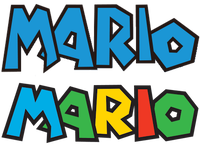


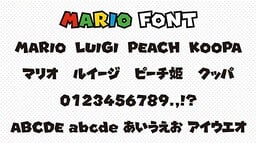




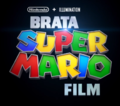


![Lettering seen in the May 2023 game update trailer for the Game Boy Advance - Nintendo Switch Online application[2]](https://mario.wiki.gallery/images/thumb/4/45/GBA-NSO_trailer_2023-05_screenshot_-_available_may_26.jpg/120px-GBA-NSO_trailer_2023-05_screenshot_-_available_may_26.jpg)



